The Samohi

ASB ELECTION
A VERY CALIFORNIA
CONTROVERSY PAGES 2 AND 5 BOYS’ SOCCER GOES TO STATE PAGE 13
CENTERSPREAD PAGES 8 AND 9

by


ASB ELECTION
A VERY CALIFORNIA
CONTROVERSY PAGES 2 AND 5 BOYS’ SOCCER GOES TO STATE PAGE 13
CENTERSPREAD PAGES 8 AND 9

by
Managing Editor
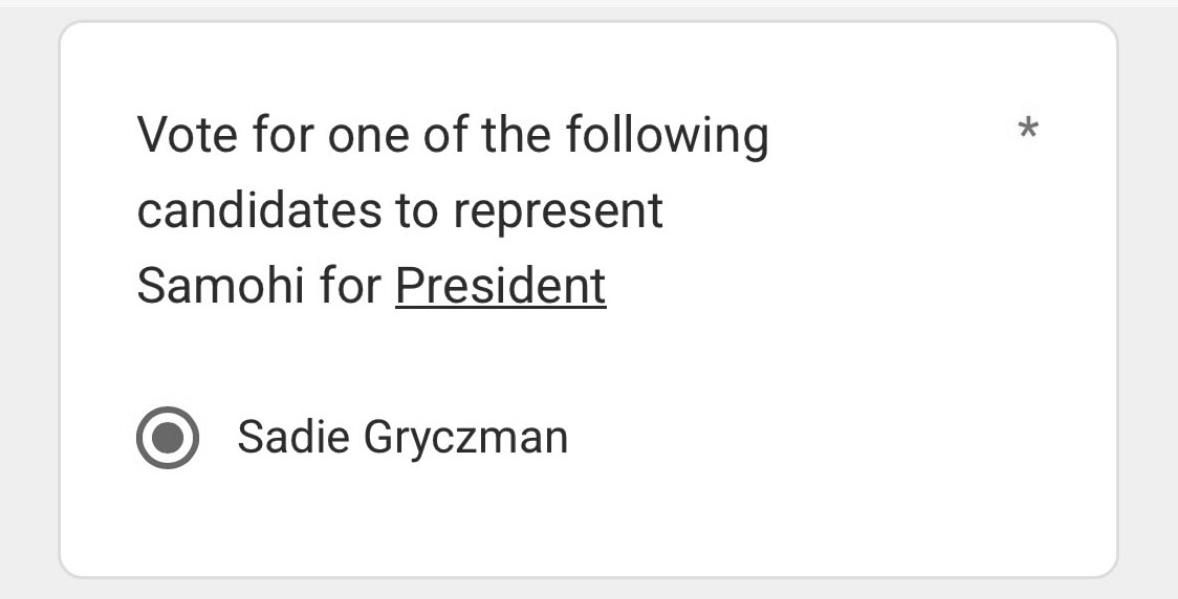
On Wednesday, Feb. 12, Samo’s Associated Student Body (ASB) held their annual election for the upcoming school year’s Executive Board. Unlike years prior, this year, the presidential candidate listed ran unopposed, with no option for an alternative candidate.
In ASB elections, any unopposed candidate must receive twothirds of the votes to receive their position. The “other” option, generally offered on the ballot, allows students (who must vote for every position on the ballot to vote for any candidate at all) an alternative.
M House principal Lissette Bravo, the administrator in charge of overseeing ASB, was responsible for creating the election Google Form that students received. She claimed that she had multiple eyes on the form, so the fact that there was no “other” option under the presidential candidate was accidentally overlooked. Principal Marae Cruce was one of the people who viewed this form before it was published.
“Do I think it would be fair to require everybody to vote for one person? No,” Cruce said. “That’s why there should be an optional button.”
After this mistake was brought to Cruce’s attention at the end of flex time (right after students voted), the form was changed to include an “other” option. There was then an announcement made over the loudspeaker that allowed anyone to go back through their form and edit their responses. As some people said that they didn’t hear the announcement, the following week, the form was re-
published, announced again over the loudspeaker on Tuesday, Feb. 18 and emailed to students.
Student Maya Jarmakani (’26) felt that regardless of one’s candidate preferences, they should be given the option when voting.
“I found it kind of odd,” Jarmakani said. “I feel like there wasn’t another option; even if you didn’t want Sadie, you could only vote for her because she was the only option. But personally, with my opinions, I wanted Sadie to be president.”
Only about two weeks before the initial form was released to students, Intended presidential candidate Gelila Mihret (’26) was disqualified from the ASB election for missing the deadline to submit the required “Election Information 2025” Google Form. At an official candidacy meeting after school, where candidates who intended to run sign a contract abiding to campaign rules, a Google Form was released online (in past years it was signed on a physical copy in this same candidacy meeting). After the meeting, Mihret was given until the end of the day to complete the form. Mihret claims her phone died right after the meeting and her charger was at a friend’s house (she provided screenshots she believed to prove this), which led her to submit the form the following morning at around 8 am.
“I f we’re going to be going above and beyond for leaders on campus, this is just like any job application...”
have disqualified other students. That’s across the board,” Tovar said. While the decision by administration was made because of Mihret’s failure to complete the candidacy form in time, according to Mihret, she believes other factors contributed to her inability to run.
“One irresponsible action just painted me as an irresponsible person, when I’ve proven time and time again I’m not,” said Mihret. “I love ASB. It’s a passion of mine. It’s more than a class to me, and for all that I’ve done—all that I’ve worked for and all of my dedication and hard work—to be not even taken into consideration when making a decision like that, made it feel a little biased.”
“ It felt like this form wasn’t the only reason I was being disqualified.”
For about a month in the first semester of her Junior year, Mihret was placed on academic probation, to which she attributes to personal, outside-of-school reasons (academic probation simply serves as a formal warning that a student’s academic performance is below minimum standards). This event was brought up again during her disqualification meeting. Mihret expressed that she felt Tovar was using her past academic probation to undermine her abilities as a candidate.
Mihret was informed of her disqualification by ASB advisor Stefani Tovar, Bravo and Cruce two days later. Mihret has been in ASB since seventh grade, and class president for two consecutive years. She has served on the ASB cabinet for all of her years in high school and middle school. Having already paid for the campaigning materials, she decided to appeal the decision of her disqualification twice. Mihret was ultimately denied entry into the presidential race.
“I think that there needs to be consideration to the fact that this is an application for a leadership position, and if we’re going to be going above and beyond for leaders on campus, this is just like any job application,” said Cruce. “You haven’t completely finished an application until you’ve done all those steps.”
Tovar declined to comment on any individual students, however she felt that this disqualification process was standard.
“We do have eligibility requirements and as far as eligibility, we
“It just felt like being attacked all at once. [...] They’re bringing these things up while literally inducing a panic attack, like to bring all of those things up and not just tell me, ‘Hey, you’re disqualified because of this. It’s unfortunate. I’m sorry, but it’s how it is,’ just seemed very unfair, and it seemed very biased. It felt personal,” Mihret said. [...] “It felt like this form wasn’t the only reason I was being disqualified.”
During the 2023-2024 school year, ASB for the first time allowed students from outside the class to run for executive positions. Before this change, students needed one prior year of experience in ASB to be eligible to run. When asked in an interview last year, Tovar championed the change as representing the core ideals of the program.
“The decision to make these changes was driven by a desire for a more inclusive and competitive process that recognizes leadership in various forms,” Tovar said.
Current Vice President Ry Bardacke (’25) believes Tovar’s decision to disqualify Mihret contradicts what ASB was working to improve.
“If [Tovar] really wanted to have an election where there’s more than one person and it’s competitive, then she would have done everything she could have to let Gelila run,” Bardacke said.
thesamohinews@gmail.com
Addelyn Fiore Staff Writer
The Palisades and Eaton fires, which occurred in January, have significantly impacted California’s marine ecosystem. With a large amount of debris contaminating the ocean, there is potential for an ecological crisis. Approximately 4.5 million tons of toxic waste were generated from the fires, some of which is now being washed up on the Los Angeles Coast. This includes harmful pollutants and carcinogenic [cancer-causing] chemicals. With this, the Los Angeles County Department of Health prohibited swimming at beaches, with undisclosed dates of when they are going to be opened back up to the public.
Santa Monica Beach, among others, is now full of endless thick lines of dark black and brown debris with ash and remnants of trees, homes and brush being washed up from the ocean along with water discoloration.
Samo marine biology teacher Benjamin Kay has his own concerns about the beach.
“What I’m worried about for Samo students and families is that people are going to, based on early scientific results, say it’s okay to go to the beach and go to swim. They’re going to then expose themselves to maybe these smaller concentrations of toxic chemicals,” Kay said.
“With repeated exposures, it can lead to long-term health issues such as cancer.”
Although the debris is causing health concerns, clean-up processes have been delayed due to hazardous conditions. This is directly tied to the possibility of further long-term damage to ecosystems and the shoreline. The longer the debris stays, the higher

The Samohi is a monthly newspaper by, for and about Santa Monica High School students. Our goal is to empower the student body through information. We do not represent the views of the administration or staff. We do not endorse advertisements placed in our paper.
the chance of it leaching into the soil and sand. This is coupled with offshore winds that can carry these hazardous particles and spread them further along the coast.
Many samples of debris from various impacted beaches along the coast have been sent off to local departments to be tested, with hopes of determining the percentage of harmful chemicals and fecal bacteria. The ultimate goal of this work is to determine when beaches can be reopened to the public.
The sediment has leached off into the ocean different types of nutrients providing good conditions for algal blooms with many negative repercussions affecting marine life.
Algal blooms are a big contributor to marine life dying for various reasons. The decomposition process of algae consumes large amounts of oxygen, creating dead zones where marine life suffocates due to lack of oxygen. Additionally, there are neurotoxins that are emitted from harmful algae blooms that poison fish and other animals. With animals being killed off it also affects the marine food chain, amplifying marine life death and worsening the already dire situation happening with ocean pollutant contamination.
With so much contamination, many Samo students are affected, more specifically surf athletes. The Department of Health has deemed Santa Monica waters unsafe, making the Samo surfers ineligible to train there. Since January, the surf team has been unable to train in Santa Monica, significantly disrupting their training plans. Consequently, they travel to Huntington Beach for water practice, where contamination levels are lower.
Samo surf team captain Sierra Pacifici (’25) speaks out about how water contamination has had a big impact on the surf program.
“Right now we are doing a lot of activities on land, such as skate-
Editor-in-Chiefs
Aili Forster
Sara Javerbaum
Managing Editor Sienna Bevan
Business Manager
Cleo Topp
News Editors
Dalia Puchalt
Liam Sauer
Opinion Editor
Claire Harrison
Student Life Editor Ryan Kim
A&E Editor Max Kehoe
Centerspread Editor
Emi Yamashiro-Herget
Photo Editor Manny Lopez

boarding, ab workouts and on-land workouts, so this has resulted in us not being able to surf for a little over 2 months. This has had a major impact on our overall performance,” Pacifici said.
This uncertainty surrounding water safety has forced surfers to stay on land, significantly affecting their training and performance.
“Right now there is a lack of transparency with the Los Angeles Health Department, they’re not sharing all the information and it’s very hard to find the information online,” Kay said.
“So until I, as a scientist, see the ways and sample size and the methods used to do the science, I am going to remain skeptical about any scientific result that says it’s safe to go in the water.”
The state of the beach will be continuously monitored by public health officials and scientists throughout the coming months. Before entering the ocean, it is important to remain cognizant of the relevant information regarding safety.
Art Editors Kayman Mangan
Raha Ghoroghchian
Social Media Manager
Olivia Stephansen
Sports Editors Addie Burns Louis Rotgin
Faculty Advisor Elizabeth Stapleton
thesamohinews@gmail.com
Staff Writers
Athena Barefoot, Laurel Cohn, Ryan Colvin, Addelyn Fiore, Emma Godfrey, Alisa Ignatenko, Sia Kresch, Leo Lucente, Koi Lerner, Eugene Naruse, Yaretzi Preza, Arata Sakamoto, Kamerin Shakir, Imani Toler, Hope Wang
Leo Lucente Staff Writer
After over eleven years of conflict, world leaders have met to discuss a resolution to the Russo-Ukrainian war. President Donald Trump, who made promises to end the conflict in his first 24 hours in office, has been in negotiation talks with both Russian President Vladimir Putin and Ukrainian President Volodymyr Zelenskyy since mid-February.
“I
At its core, the war has been fought over international influence and dominance. Since Ukraine gained independence following the collapse of the Soviet Union in 1991, Russia has aspired to regain dominion of the country, or at the very least, save it from the influence of Western Europe and the US. When Russia first invaded Ukraine on Feb. 22, 2022, Putin gave a speech in which he justified the attack, calling Ukraine a militant and neo-Nazi state.
on this occurrence, claiming Russia would not break a ceasefire and stating that Putin has an apparent respect for him. The president went on to comment extensively on the 2016 election controversy surrounding Russia’s involvement and how it strengthened his relationship with Putin. Finishing the impromptu speech, the president dismissed the press.
“This is gonna be great television, I’ll tell you that much,” Trump said.
f to achieve peace, you really need me to give up my post, I’m ready.”
“...Russia has a moral obligation to do something about security in the region,” Putin said. “...Ukraine is a puppet of the West…”
Then-President Joe Biden interpreted the attack differently and made comments about what it potentially signaled about Putin’s aspirations.
“[Putin] wants to, in fact, reestablish the former Soviet Union. That’s what this is about,” Biden said.
Meeting in Saudi Arabia and over the phone, Trump and U.S. officials began working with Putin and Russia on peace negotiations in February. Zelenskyy, notably absent from these initial talks, criticized Trump and Putin for seemingly going over his head and said Ukraine would not agree to a deal in which Ukraine doesn’t have a hand. Trump and Zelenskyy have further butted heads in regard to U.S. military aid. According to the Department of State, the Biden Administration provided over $60 billion in aid free of charge. Trump has attempted to create a deal for mining Ukraine’s rare earth
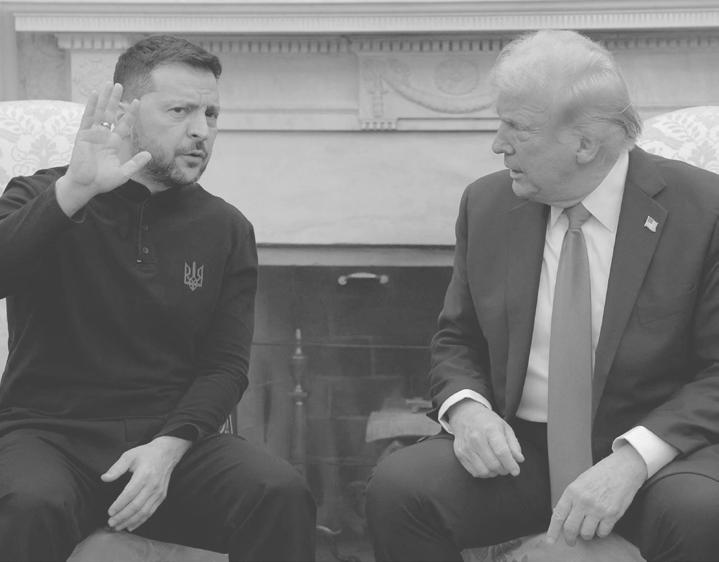
mineral deposits in exchange for continued aid. Despite Zelenskyy’s rejection of the deal, the U.S. has continued providing aid for the time being. According to a Pew Research Center poll, of the 75 percent of Americans who felt strongly, 45 percent of citizens believe the aid the U.S. is providing to Ukraine is warranted while 30 percent believe it is too much.
Tensions between Trump and Zelenskyy exploded on Feb. 28 when a televised meeting between the presidents escalated into a shouting match. Zelenskyy sparked the argument by offending Vice President JD Vance with his perceived lack of respect for the Trump Administration and criticism of its diplomacy.
“You will feel [the repercussions of the war] in the future,” Zelenskyy said.
“You’re in no position to dictate what we’re going to feel,” Trump said. “...You’re not in a good position, you don’t have the cards right now… You’re gambling with World War III.”
The leaders spoke over each other for several minutes about a ceasefire deal and American aid. The argument was interrupted by a reporter’s question about the possibility of Russia breaking the ceasefire. Trump casted doubt
Natan Krylov (’25) is a Russian-born student who lived in the country until 2022. After protesting Russia’s invasion of Ukraine, Krylov’s mother was briefly incarcerated and beaten in jail, before moving herself and her son to the U.S.. He pointed out that not all Russians are in favor of the war and highlighted the devastating casualties of both Russian and Ukrainian people.
“This is a crime against humanity, against all people in Russia and Ukraine,” Krylov said. “I think that the U.S. must push both Russia and Ukraine to sign a peace treaty.”
Trump and his administration have been determined to work out a deal between the warring nations. On March 7, Trump stated he is “strongly considering” imposing sweeping sanctions and tariffs on Russia until peace agreements are made. This would create extra leverage for Ukraine in negotiations who currently appear unwilling to give up territory and a possible admittance to NATO. In a NATO press conference on Feb. 12, U.S. Defense Secretary Pete Hegseth said that NATO membership for Ukraine was unrealistic and suggested that the country should abandon hopes of returning to its pre-2014 borders and prepare for a negotiated settlement.
While the war has only been at the forefront of international news since Russia’s invasion in 2022, it began in February of 2014 following Ukraine’s Revolution of Dignity. The Revolution of Dignity started after then-president Viktor Yanukovych’s decision to not sign a political association and free trade agreement with the European Union. Yanukovych chose closer ties to Russia and was ousted by protesters as a result. Ukraine reinstated its 2004 Constitution of Ukraine and shifted their political allegiance away from Russia and towards the West. In response to Ukraine’s attempted distancing, Russia annexed Crimea and supported pro-Russia Separatists’ attempt to secede from Eastern Ukraine’s Donbas region in a conflict known as the Donbas War.
The war was hyper-escalated as Russia launched a full-scale invasion of Ukraine following Ukraine’s refusal to vow never to join NATO. Since the invasion, the war has taken the lives of hundreds of thousands of soldiers and tens of thousands of Ukrainian civilians. Of Ukraine’s population of 41 million, 16 million people have been displaced, eight million domestically and eight million internationally. The sheer number of casualties and refugees rivals no conflict since World War II.
While Ukraine’s constitution prohibits elections during wartime, Trump and Putin have still criticized Zelenskyy for overstaying his term. Trump has gone as far as to call the Ukrainian president a dictator as well as pushed the Kremlin narrative that Ukraine started the war.
On Feb. 23, Zelenskyy proposed stepping down as president if it would mean an end to the conflict and Ukraine’s admission to NATO.
On the three-year anniversary of Russia’s invasion, Zelenskyy spoke to a forum of government officials in Kyiv.
“If to achieve peace, you really need me to give up my post, I’m ready,” Zelenskyy said.
The war is not over and tensions between Trump, Zelenskyy and Putin remain high.
Negotiations may last for a while as the parties struggle to make a deal that fulfills both parties’ priorities.
Eugene Naruse Staff Writer
Both on the campaign trail and from the Oval Office, President Trump has been outspoken about his disdain for the Department of Education, calling it a “big con job,” pledging to bring “school back to the states” and declaring his intention to dismantle the agency. His administration announced on March 6 that an executive order instructing Education Secretary Linda McMahon to begin the process of shutting down the department could be signed as soon as a week later. Trump has already begun efforts to minimize the agency’s functions, threatening to withhold federal funding from schools that don’t comply with his political priorities.
Established in 1979 by President Jimmy Carter, the Department of Education is responsible for administering federal funds to states and local school districts, researching and collecting data on education, enforcing civil rights laws and overseeing federal student loans. The department’s annual budget of $240 billion is used to fund programs such as Title I for high-poverty schools and Pell Grants, which are given to college students with low family incomes and do not require reimbursement. Other vital programs include the Individuals with Disabilities Education Act (IDEA), which supports students with disabilities, and management of student loans and financial aid, including administering the Free Application for Federal Student Aid (FAFSA).
Although Trump has repeatedly emphasized his plans to dismantle the department, proposals for its elimination would require congressional approval and likely face political challenges. A proposal to end the agency would need 60 supporters to move to a vote in the Senate, and with 53 Republican senators and currently no Democrats or Independents supporting the motion, any bill can be expected to be shut down. A bill to dismantle the department was revoked just last year, with 60 Republicans and all 215 Democrats voting against it in the House of Representatives.
Although vocal about dismantling the department, the Trump administration has stated that it would not seek to end federal support programs like Title l and IDEA. These programs are administered separately through different laws, making it more difficult to repeal them. Additionally, the law states that even if the department is disbanded, other agencies are required to assume responsibility for its current roles. Those in favor of dismantling the department have proposed that the Treasury Department take over the federal student loan program, or that the Justice Department could enforce civil rights laws that pertain to education. However, fears that a sudden change in management could lead to disruption in the programs have been vocalized by the public and politicians from both sides of the board.
With any plan to dismantle the department likely falling into gridlock, one of the most significant ways the Trump administration is attempting to reshape education is by withholding federal funding and minimizing the department’s responsibilities.
received roughly $16.3 billion in total federal funding last year for its 5.8 million K-12 public school students, which includes $1.33 billion for serving students with disabilities, more than $1.5 billion in Pell Grants for college students and more than $2.1 billion in Title I grants.
Three percent of SMMUSD revenue also comes from the federal government, according to the latest 2024-25 Preliminary Budget breakdown from the district. This includes $1.5 million for targeted Title I programs and $2.4 million for the 1317 students enrolled in special education programs at SMMUSD.
Victoria Hurst, director of special education at SMMUSD, explained how the program and district are impacted by federal funding streams.
“Funding is all used for staffing. So in special education, we have teachers, we have paraprofessionals, we have occupational therapists, speech therapists, special PE teachers, physical therapists, counselors or psychologists—so

anything like that falls under the federal funding,” Hurst said. “Funding special education programs are important because they help our students who need extra support. Our goal is to help our students thrive the best way that they can, and we need additional resources [federal funding] to help us meet that goal. The funding for staffing, especially, is important as it directly impacts our students.”
However, recent actions from the Department of Education have put similar resources across the country at risk, especially if schools continue to resist the administration’s ideological stance on issues like race and gender.
“ O ur goal is to help our students thrive the best way that they can, and we need additional resources [federal funding] to help us meet that goal.”
There have already been major budget cuts to the Department of Education, spearheaded by the Department of Government Efficiency (DOGE), which Elon Musk oversees. According to the DOGE website, over $900 million has been cut with the termination of 89 contracts— mostly focused on the Institute of Education Sciences, the research sector of the agency. Additionally, on Feb. 28, the department offered $25,000 buyout plans to all employees ahead of “a very significant reduction” in the workforce, giving them until March 3—or three days—to respond.
The Californian education system receives major resources from the federal government. According to Education Data Initiative, the state
Currently, Trump has ordered investigations into the Minnesota State High School League (MSHSL) and the California Interscholastic Federation (CIF) for violating “federal antidiscrimination laws related to girls’ and women’s sports.” This was following announcements from both organizations that they would abide by state laws allowing students to participate in sports based on their gender identity, contradicting Trump’s executive order decreeing that he would keep “men out of women’s sports.” In the same executive order, Trump also overhauled Biden-era Title IX policies which prohibited “discrimination on the basis of sex in education programs and activities that receive federal funding,” essentially expanding the definition of women to include transgender athletes. Trump, however, has re-interpreted the law to argue that allowing transgender athletes to compete is a form of discrimination against women.
Additionally, the Department of Education gave schools and colleges with Diversity, Equity and Inclusion (DEI) programs and race-specific programs until the end of February to abolish these policies or risk losing federal funding. These “race-specific programs” include financial aid targeting a particular race, race-related classes and special ethnic graduation ceremonies. As of now, how and when federal funds could be cut at schools that don’t comply with these policies is unknown.
Imani Toler Staff Writer
Plans to construct an upgraded building on the Samo campus are set to begin in the summer of 2026. The district has finalized their decision in hiring contracting firm Erickson-Hall Construction Co. The new building, named the Student Services Building, will replace the Business Building, creating a new space for student use.
When hiring the contracting firm, a primary concern was the location of the new building in the center of the Samo campus. It is pertinent that construction is as efficient as possible so that it does not interfere with students’ daily life on campus or complicate foot traffic. The construction workers and equipment will primarily enter from Michigan Gate, potentially blocking students’ direct access to the Language and English buildings. However, the team will take a
The new Student Services Building will host a variety of student help services, including the mental health counselors’ offices, nurses’ offices and a center for providing student resources. Additionally, the new Black Box Theater will reside on the western end of the building across from Barnum Hall, hosting Samo Theater’s rehearsals and performances. Carey Upton, chief operations officer for SMMUSD, remarked on the renovations being made to the Samo campus, focusing on how the modernized facilities at Samo will better serve students.
“There’s a new art gallery, there are classrooms—which includes the journalism classroom, there’s the campus commons area, the Vike’s Inn, College and Career [Center] and a Student Support [Center],” Upton said.
Although Samo students are enjoying a cam-
Tuesday, Feb. 18 marked the day that all four Malibu schools reopened, as the air quality and road status was deemed safe for students to return back to school for in-person learning. Due to the fires plaguing Los Angeles county earlier this year, all four Malibu schools, Malibu Elementary School, Webster Elementary School, Malibu Middle School and Malibu High School, have been closed since the end of the 2024 fall semester on Dec. 20.
With school back in session, road closures in the area are beginning to alleviate. School buses, Malibu residents in the burn area and transport for essential businesses were granted permits to access the Pacific Coast Highway (PCH) beginning Feb. 20. As PCH remains an “active work zone,” minimal permits are being issued in order to limit traffic and ensure safety across the highway.

It was taking a long time before, but now it’s not so bad,” Jarvis said. “It’s kind of crazy to go up along the road and see all the houses that burned down.”

Samo’s Surgical Skills Club, run by president Alex Sebastian (’26), hosted a cardiothoracic surgery workshop on Friday, Feb. 25. The event was in collaboration with Paul Chang, a world-re- nowned educator for students interested in surgery. Chang, the Cardiac Surgery Surgical Skill Education Center founder at Stanford University, has over 35 years of experience in the field of medicine. In 2013, he founded the American Academy of Medicine & Surgery, furthering his appreciation for education, with his expertise being in surgical skills education.

With the intent to bring accessible surgery education to students, the Surgical Skills Club provides real-life experience in the medical field at an amateur level, cultivating students’ interest in medicine by providing them with the chance to explore their passion for surgery. Feb 25. from 4-8 p.m., students had a chance at practicing porcine (pig) heart dissection, vessel ligation and suturing. Sebastian remarked on the unique opportunity presented to students in the club.
“What’s unique about this is that we are offering an extremely high level of surgical education to high school students,” Sebastian said. “Our high school students have also built up skill sets more advanced than a lot of medical students or even surgical residents.”
Art by Kayman Mangan
Santa Monica’s own branch of the beloved restaurant Din Tai Fung had its grand opening on Feb. 28 on the third floor of the Santa Monica Place next to the 3rd Street Promenade. A Taiwanese chain with a speciality in Chinese cuisine, Din Tai Fung offers an array of food options; cucumber salad, xiao long bao, dumplings, fried rice and chocolate buns are only some of the many world-renowned dishes served.
The restaurant chain has 11 California locations with its new fifth Los Angeles location consisting of an outdoor heated patio, an ocean view and an interior design choice of dumpling-styled booths.
The opening is an opportunity for the Santa Monica Place to revive itself to its former glory, helping out local businesses in its wake. According to a report made by Morningstar, the mall’s value has plummeted 59 percent since 2017, leading to unpaid loans from mall owners, but recent
investments leave Santa Monica citizens in high hopes. Samo Student Morgan Watts (’27) is optimistic about the Din Tai Fung opening and feels that it will rejuvenate the Promenade, which has declined since the pandemic.
“I’m excited since it looks relatively big, and I’m sure it will bring attention to the promenade again. I’ve only been to the Din Tai Fung in Century City, which is relatively far, but now I’ll have one that’s a 10 min drive from my house, which is great,” Watts said. “I love the high quality food, especially their spicy wontons.”
The first few days of the restaurant’s soft opening on Feb. 20 are exclusive for friends and family, serving a more limited menu. Additionally, the company has stated that 100 percent of profits from their soft opening and grand opening will go towards LA wildfire relief donations.
thesamohinews@gmail.com
Proposition 36, passed by California voters in November 2024 with an overwhelming 69 percent majority, aimed to reform the state’s approach to repeat offenders of certain drug and theft crimes. However, despite the strong voter approval, the proposition has encountered several issues in its implementation, particularly concerning funding and logistical support. California Gov. Gavin Newsom, who has faced major criticism from the public for not properly supporting the proposition, did not allocate sufficient funding to support the extensive rehabilitation programs that are required to make this law work effectively. This resulted in courts across California struggling to implement and maintain the resources needed to carry out the law’s provisions.
A key concern within county courts is the availability of existing rehabilitation programs. The proposition allows prosecutors the option of imposing “treatment-mandated felonies” instead of traditional prison sentences for people convicted of certain third-time drug offenses. Under Proposition 36, a “treatment-mandated felony” is a sentencing alternative that sentences eligible offenders to mandatory rehabilitation facilities or mental health treatment rather than prison time. This option is designed to break the cycle of incarceration by addressing the root causes of crime, such as substance abuse or untreated mental issues. In directing offenders to rehabilitation or mental health facilities rather than just incarcerating them, the proposition aims to reduce recidivism, or the tendency of a convicted criminal to reoffend.
However, the law has vague definitions and lacks consistent standards, which has created confusion as to how authorities should apply this sentence. There are many cases where judg-
es and prosecutors are left to decide whether a defendant is a good candidate for treatment or whether they should be sent to prison. This has created inconsistencies across counties, especially in the areas where resources are limited.
Many counties have reported difficulties finding enough facilities to meet the increased demand for treatment, with some counties scrambling to expand their infrastructure. Orange County, for instance, has set up a specialized “Prop 36 court,” which streamlines the process for these cases. County officials have acknowledged that a long-term plan is in development to ensure sustainable treatment options for those affected.
While some counties have managed to launch creative solutions, others have faced significant challenges in implementing the new prop. Many counties are overwhelmed by the demand for treatment programs and the lack of funding to meet the offenders needs. As a result, many defendants have been left in a legal race, facing delays in receiving the rehabilitation they are now legally entitled to. This issue was what initially detracted Newsom from the proposition in the first place, as he anticipated having to make these cuts. In a recent interview with The Sacramento Bee, Gov. Newsom shared his concerns about the prop’s funding.

Art by Kayman Mangan
“Proposition 36 locks in a requirement, but it locks
out money because at the same time it cuts drug treatment money for local governments. That’s a conundrum for local municipalities, and one that I’m very concerned about,” Newsom said. “And therein lies my concern and opposition to that initiative.”
Additionally, due to the lack of funding for Proposition 36, it has become increasingly difficult to establish these treatment programs without diverting resources from other essential social services. Because the proposition relies heavily on state and local funding, counties have been forced to relocate resources from other critical programs such as mental health services, rehabilitation centers and homeless support initiatives. Mental health facilities, many of which are already underfunded and stretched thin, have been impacted as they are being forced to prioritize emergency cases or reduce the number of available beds for ongoing treatment. Similarly impacted is the social services system, leaving people who need long-term care or support services without reliable access. County officials have acknowledged that a long-term plan is in development to ensure sustainable treatment options for those affected, but without a dedicated increase in funding, the trade-off between supporting drug treatment programs and maintaining essential social services is still a challenge.
As Proposition 36 continues to evolve, its success depends on the state’s ability to address the funding gap and establish a more comprehensive and standard system of treatment across all counties. Without proper financial backing, the law risks falling short of its intended goals. Criminal justice advocates hope that with further state investment and more consistent implementation, Proposition 36 can help reduce recidivism and offer a more humane alternative to prison.
We encourage readers to first read the related news article on page 2 for important context. This will provide a clearer understanding of the issues discussed and help frame the opinion presented by our staff member.
Laurel Cohn Staff Writer
From the change in advisor leadership, to the questionable election mishaps, the Samo Associative Student Body (ASB) has suffered from much internal turmoil. This has prompted many questions about the leadership in the class and transparency within the association itself.
While there has been ongoing discussion around ASB for years, it’s caught more attention with the recent controversy regarding the ASB election, where there was an absence of an “other” button. When asked about the process the election ballot must endure before being sent out to the student body, almost all the members in ASB had little to no idea. Members were also in the dark as to who actually made and approved the ballot. They were equally as unaware as to why there was such a short time period for voters to amend their decisions when the corrected ballot was sent out. If those who are supposed to be representing us (the student body) are not even fully aware of the actions that will directly affect us, then what even is the purpose of ASB?
Current ASB Co-Head of Community Service, Isabella Rosales (’28), expanded on the need for improvance in ASB.
“I was really confused. Because up until, I would say a couple days before the election, I thought there were two presidential candidates on the ballot,” Rosales said. The singular choice for the presidency completely undermined school democracy by forcing votes. There were two, fully qualified candidates, Gelila Mihret (’26) and Sadie Gryczman (’26). However, by a last minute disqualification, only one was allowed to run. In all previous ASB elections, there has always been an “other” button, allowing voters to write in another
candidate. The exclusion of this essential choice creates an inaccurate representation of the student body and their diverse backgrounds, views and opinions.
Mihret was disqualified on the grounds that the candidate turned in a form (stating that the candidate would abide by all campaigning rules) late. Mihret felt that this painted her as an irresponsible applicant in the eyes of ad ministration and Stefani Tovar, who serves as the ASB teacher and activities director. Senior Class President Ben Komlos (’25), believed the decision to completely disqualify Mihret was hypocritical, given the past changes to election qualifications. The qualification of needing to be in ASB the year prior to one’s term on the Executive Board was changed to allow current ASB Executive President Ethan Fitzgerald (’25) to run.
leadership could’ve done much more to allow Mihret to run for the presidential position.
“It’s just weird seeing it now, because her whole goal was to - or what she said was her goal - was to open up the polls or the position to anybody and get a more competitive race. But then this year there was only one
“The only reasons that we’ve gotten involved is when we’ve had students asking us to get involved. So students have asked for more of a presence in the classroom, so we have responded,” Cruce said.

While some students may have asked for this, there is still a way to go about it to facilitate student-let processes in the classroom. Mihret explained how she feels like this has overridden student authority in ASB.
“The lack of transparency completely takes away power and authority from students who were elected cabinet,”Mihret
“I believe that Tovar doesn’t believe in making it fair. [...] But if Tovar really did care about making it a competition - especially for the presidential executive position - she would’ve allowed Gelila to run against Sadie,” Komlos said.

ASB members have been widely outspoken about faculty encouraging competition in elections, so it’s confusing and hypocritical that there would only be one candidate for such an important executive position. If the election really wanted to be competitive, a trivial thing - such as turning a form in a few hours late - wouldn’t have stopped Mihret from running. Mihret expanded on how she felt upset that there were exceptions made for previous candidates, specifically Fitzgerald, and that the same leniency was not shown for her.
“In the way that he [Fitzgerald] was spoken about and just presented as a candidate - it felt very like ‘Oh he’s the one Tovar wants.’ It seemed like he was Tovar’s candidate and the others were just running,” Mihret said.
Given that ASB members felt rules were adjusted for Fitzgerald to run, some believed that faculty
noticed of Tovar’s tendency for preferential treatment towards students in the class.
“There are some people in the class who don’t hold a lot of respect for our advisor. She definitely reciprocates that and it’s just kind of a cycle where they don’t listen to each other and they don’t take [each other] seriously,” Bardacke said.
ASB is supposed to be a student-run class, however when the class turns into something more controlled by the teacher, turmoil will ensue. Students won’t be able to learn from their own experience - which is more impactful and memorable - and only learn from being told what to do. Bardacke expressed his dislike for the culture change in the class.
“There’s definitely been a huge culture change in the class; it felt more student-led in previous years, when it was designed to be a student leadership class - students were learning their own skills. And now the teacher has a little more authority in the class, and exercises it, and it feels like she’s the one who’s pushing us to get our work done all the time,” Bardacke said.
While there has been a shift in tone in the classroom, Principal Marae Cruce explained that there was student input behind that.
“We all feel like figureheads.
Even our presidents don’t really have presidential authority. We oversee finances but then don’t have a say in financial issues. We find

ency in any governing body is crucial. In a governing body that is supposed to navigate the au thority of school leadership, but also represent the student body, it’s understandable how transpar ency can be hard to come by. However, if the students representing us are unaware of what’s going on in their own association, the “student body” part of ASB is lost.
Journalism has long been considered a public good, an essential component of democracy that informs the public, holds powers accountable and fosters discussion. In an era where misinformation is rampant, restricting access to credible news sources by hiding them behind a paywall restricts the general public from receiving credible information. Big media corporations like The New York Times and The Washington Post generate substantial revenue, yet they still hide essential reporting behind a paywall. This isn’t about sustaining journalism; it’s about profit maximization.
The worst part is that the people who lose out the most are those who rely on accurate news but can’t afford to pay for a monthly subscription. For people who can barely make ends meet, paying for news is just another expense they can’t afford. These individuals are often the most in need of quality information— whether its about local policies, healthcare or global issues that affect their lives—but paywalls make this access out of reach.
Journalism is a struggling industry. Print newspapers have indeed suffered
and online advertising revenue alone isn’t enough to sustain quality reporting. Small, independent and local news outlets often genuinely need subscriptions to survive. However, the same cannot be said for massive media corporations with multiple revenue streams like advertisements and outside funding. These companies have the financial means to provide free access to critical news, but instead, they prioritize boosting profits. Blocking access to crucial information directly undermines the core mission of journalism—to serve the public. Beyond financial concerns, paywalls directly shape how people consume information. When reputable news sources are inaccessible, people turn to whatever is free—which often means biased blogs, social media hot takes and outright misinformation. This creates an almost

dystopian regulation on who can view credible news sources and who can’t; fact-based reporting becomes a privilege for those who can afford it, while misleading or false narratives become the default for those who can’t. If these major outlets truly cared about fighting misinformation, they wouldn’t be charging people for access to the truth.
During the pandemic, many publications temporarily removed paywalls for pandemic-related because they knew withhold - ing news would be irresponsible. But if free access is necessary during a crisis, why isn’t it necessary every day? Democracy doesn’t take breaks, neither should access to journalism. Jacob Bromell (’27) recognizes the importance of both accessibility and financial sustainability.
“News should never be censored and it shouldn’t cost anything to stay informed. But, at the same time they are businesses and they have to stay open and pay their writers,” Bromell said. “A good solution would be an outlet that has a free section for all of the important [news] headlines and then all the other sections–like opinion, A&E, and more niche things– would be behind a paywall,” Bromell said. So, what’s the alternative? Some news outlets allow a few free articles per month, which is a step in the right direction but still leaves many people in the dark. Government funding for journalism, similar to public broadcasting, is another potential solution. If journalism is as essential as everyone claims, treating it like a public good makes sense. Instead of relying on corporate greed, we should be finding ways to ensure journalism remains accessible without shutting people out.
At the end of the day, the news is power and no one should have to pay just to stay informed. If independent papers need a paywall to survive, fine, but major publications have no excuse. They can afford to make essential journalism free— and it’s time they start doing it.
thesamohinews@gmail.com

Sara Javerbaum Editor-in-Chief
The year is 1950. The Cold War rages on, and Hollywood is overrun with paranoia, betrayal and vaguely racist movies. Senator Joseph McCarthy claims that communists are lurking among us; your friends, friends, family and lovers could all be no-good commie traitors. How scary! McCarthyism—or the Red Scare—is how we remember the period today.
Fast forward 74 years and the battle lines have been redrawn —but not in Washington. Friends, in the hallways of our very own high school, we are undergoing an equally important historical transition: The Blue Scare (otherwise known as Senior Assassin).
I know it sounds unbelievable, but try to open your eyes. The game rewards betrayal, fuels distrust and distorts even the closest friendships into cold, calculated alliances. During the Red Scare, an accused communist had two choices: plead guilty or turn in three friends as communists to save yourself. Now, to avoid their own untimely death (in the game—or so they say), students in Senior Assassin will do whatever it takes. McCarthyism forced Americans to prove their patriotism through loyalty oaths and denouncements of communism. Failure to comply meant instant suspicion and often, being blacklisted. In Senior Assassin, players are cornered into alli-


ances, offering up information on other players in exchange for protection. They’ll stake out your home address. They’ll bribe your best friends. They’ll track your every moment, cornering you like an exterminator does to a rat. Work schedules, sports practices, even dog walking habits are traded like state secrets. We’re told to find solace in a safety item – usually starting as goggles, there will be a designated item that keeps one safe (which will change from week to week). The runner of the game is now even considering making the safety item a MAGA hat, weaponizing our safety to distort our perceived politics. This stinks of McCarthyism.
Luisa De Lorenzo (’25), who has assassinated seven people since the game began just weeks ago, has fallen prey to this mindset. Her friends used to describe her as bubbly, kind and sociable. In recent weeks, she’s become silent - her movements calculated. An exclusive interview with the famed killer revealed just how committed she is.
“You have to always be aware and on edge and treat everyone like they’re your enemy,” De Lorenzo said.
Last week, I dropped out of the game. The assassins around me claim I did so out of “laziness” or “because I ran out of data and had to delete the Splashin’ app” but it’s all a lie. I dropped out to make a political stand and you should too. The Blue Scare ends today.
This article is satire. It’s intended for entertainment purposes and should not be taken seriously.

I never thought I’d write an obituary at 18, but here I am. Now that you’re really gone, I guess it’s time for me to confess my love. My dad told me it was infatuation when I was younger—that you were just a guilty pleasure I’d see when my mom was on business trips, but I knew otherwise; my love
I miss the way your leather booths used to hug my butt, so warm and so tight. Oh how I want you back. How could it be that you are gone? I just don’t understand. How could I possibly have taken you for granted—you gave me so many choices. I still dream of your mediocre cuisine, like that of a school cafeteria, but with the added bonus of home. You made me feel at home. I still wait for you, how I waited for your fresh pizza to come out of the oven, cut in those sexy squares, rather than taking an old piece under the warmth of your heater. I foam at the mouth for your vanilla-chocolate swirled soft serve cones, dipped in crushed, germ-infested Oreos and covered with rainbow sprinkles. You taught me discipline—how to wait for what I wanted. However eager I was to cut to the chase when we first met—to get to your hot, oh so hot, hot bar—I learned you were worth the wait. So I took my time, and it was good for me. I ate my greens before indulging in your hot goodness—work first, play later you always said. You played hard-to-get indeed, and let me tell you, it worked. Oh souplantation, baby, come back to me—I’m sick of the chase. We can fight bankruptcy and germs together.
P.S. - About that fight we had—the one where you said something about me treating you like a prostitute—I’m sorry.

Want to read more heartfelt love letters? Check out our website thesamohi. com for more!
I know my dad used coupons, but it didn’t make a difference. I’d have you anytime, at any
I’m in love with the world, through the eyes… of a dead songwriter. Elliott Smith, I first heard your songs in the backseat of my father’s car on my way to school one morning. Since the beginning chords of “Waltz #2 (XO),” I haven’t been able to shake your hold on my life. The grainy “Needle in the Hay” music video you made near YouTube’s inception, the soundtrack of Good Will Hunting—I grew up with your presence, and without you, I wouldn’t know the power of a true emotional connection to music.
Art by Kayman Mangan


The quiet guitar picking of your “Either/Or” album. The orchestral swells of “XO.” The peculiar melodies and chord progressions of “From a Basement on a Hill.” Each album is a perfectly crafted work of art, even those released after your death. Many see you as the poster child for sad indie music, but that definition barely scratches the surface of the nuance in your songs. Sure, your popular songs like “Between the Bars” and “Miss Misery” are far from uplifting—but the quiet hope in “Say Yes,” the guidance toward addiction recovery in “Independence Day,” the almost jaunty, satirical anti-music-in- dustry criticism in “Junk Bond Trader”? Masterpieces, every one of them.
Of any artist, poet, or musician, your work has most significantly impacted mine. In moments when I felt utterly alone, in moments when I felt like giving up, your music has shone as a guiding light. Your lyrics are a constant reminder that, good times or bad, there is someone who understands every thought spiral, emotion and flaw. As a writer, I can only hope to one day emulate your ingenious manipulation of words. You will forever serve as my primary inspiration.
You weren’t too big on fame when you were alive, but your legacy has only grown since your death. I wish I could sit down with you and tell you how much your mu means to so many—how many people you’ve helped through dark times, how far your influ ence extends. I think you might be a little proud, at least.

In the meantime: I’m never gonna know you now. But I’m gonna love you anyhow.
Yours Truly,




Arata Sakamoto Staff Writer
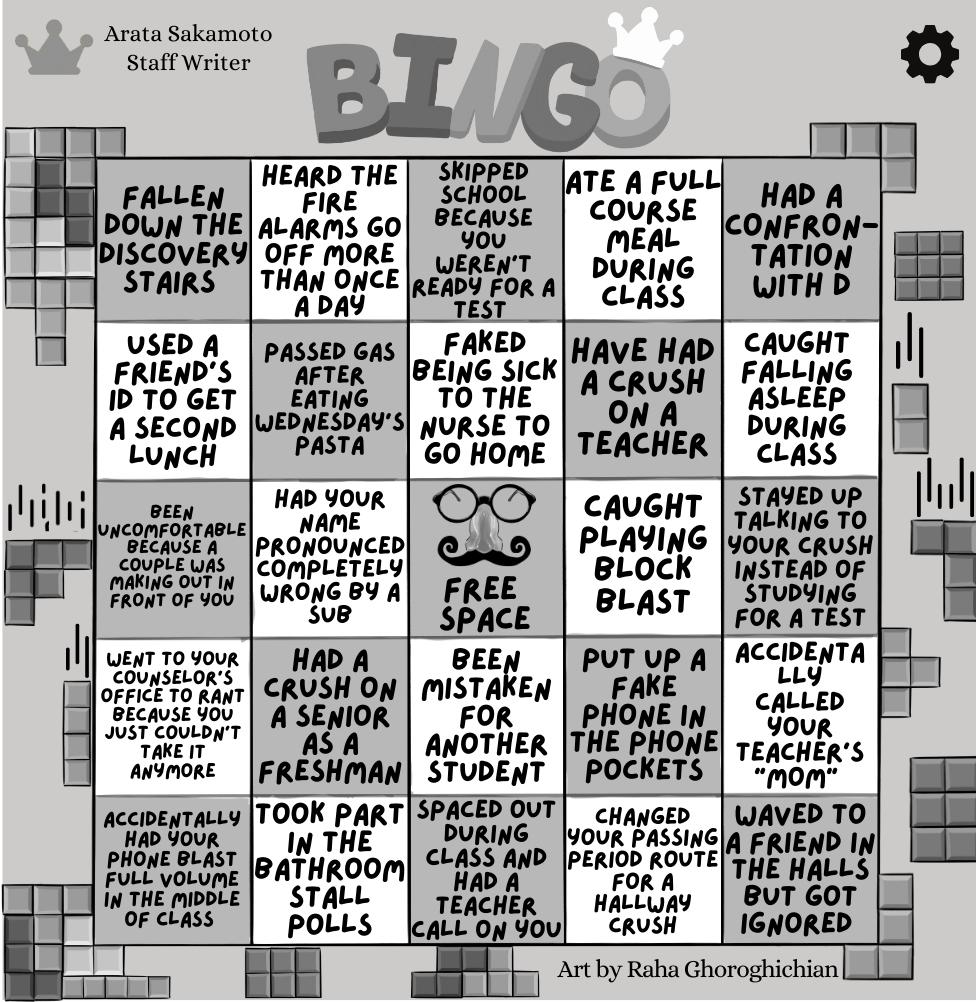

Koi Lerner
Staff Writer
On Feb. 19, Samo hosted its second club day of the year to support students who need fundraising for their clubs.
Club Day is an activity planned by the Associated Student Body (ASB) in which multiple clubs set up tables in the Innovation quad. Flex was cut short, being only thirty minutes instead of the usual hour, so students had more time to enjoy the special club day- though the rest of the schedule remained unchanged. The big draw of this club day was the food being sold and the funding for the clubs participating. There were twenty-five clubs in total, some of which were Hope for Homeless, French Club, Immersion Club and 4 Paws Club. Some available food was In-and-Out from the Surgical Skills Club, Dominos Pizza from Chicanx/Latinx Club and SWENext Samohi, C&O garlic knots from Student Wellness Advisory and many kinds of candy from other clubs. Ava Adamucci (’26), the club president for the SWENext Samohi, described the effect the club day has had on the club.
“We just started it,” Adamucci said. “We started it this semester. [Club day] was a great way to start off the new semester, especially for new clubs, to give us something to fall back on and help us start fundraising. We actually sold out. We only had four pizzas, but we made $101, so we had a good profit.”
Some non-fundraising clubs, such as The Writers Room Club, gave out free sweets. The Reflect Empathy Samohi Chapter gave out muffins and pamphlets about empathy. One club sold non-food items, the Asian Culture Team, which sold lanterns and origami— an important part of Asian

culture. Kiki Parker (’26), president of the Asian Culture Team, spoke about why they sold non-food items.
“At our club meeting, we usually do an activity,” Parker said. “So, the [meeting] before, we made the lanterns, and then we thought we might as well sell them for club day. We ended up selling a lot.”
The first club day, Sep. 18, had its focus on simply promoting clubswhere students could wander around I-quad and other locations to check out tables. Also, all clubs were required to participate in the first club day, while only a specific handful participated in the second one to fundraise. Archie Windsor (’26), the ICC and Club commissioner for ASB, discussed the difference between the two club days.
“This was a lot different,” Windsor said. “This was purely for fundraising. You could recruit a little, too, but this was just for fundraising. This was only about 25 clubs, but back in September, it was all the clubs, so we had like two hundred. This was a lot more
Hope Wang Staff Writer
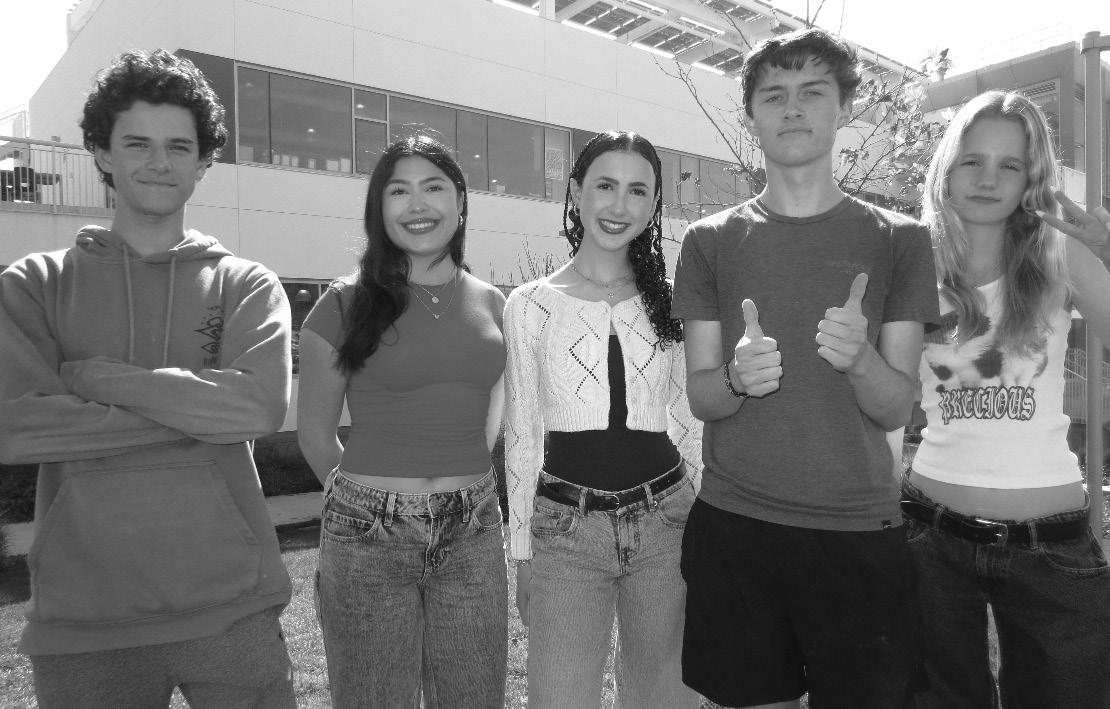
The results of the 2025-2026 school year’s Associated Student Body (ASB) elections came out on Feb. 18, and with them, a shift in school leadership will shape the direction of student life and planned events for the upcoming school year. After many weeks of campaigning, speeches and unique media pushes, such as specialized campaign videos and posters, the new ASB board is now in place, ready to take on the newfound responsibilities of properly and effectively representing their peers.
The ASB elections are crucial in representing students’ voices and playing a key role in the upcoming school year. Students put forward candidates they believe represent their interests and goals for Samo. The voting process is a test of not only ideas but also the ability to properly and visibly connect with and engage the student body. With the election now behind them, students look to their new ASB representatives to deliver on the promises made to them during the campaign. Students hope their leaders will truly reflect their concerns and work toward tangible improvements. Makana Weybright (’26) shares her hopes for the executive board to carry on.
concentrated, just in I-quad.”
ASB had been planning for the day since the beginning of the school year, though they began to focus on getting it all done mostly this semester. They started by getting clubs to sign up and letting the clubs plan the various foods they wished to sell. The clubs filled out financial forms, discussing if they wanted to spend money and estimating how much money they could make. This was due to ASB being audited this year— a tax specialist will sort through their forms to make sure the funds are where they need to be. The promotions began in early February, sending out menus, putting out posters, making announcements and posting on Instagram. Windsor discussed the struggles ASB had with promoting and planning the club day.
“I think it was really good that kids could see the menus on Instagram,” Windsor said. “It’s hard to target everyone [though], so maybe next time we could put up more posters and stuff like that. [Planning] was kind of [disorganized] on ASB’s end. We didn’t know exactly where the tables were going to be or anything like that. So I should have just made a map before, just so everyone could know where they were.”
Despite those struggles, the clubs who needed fundraising were able to sell food and raise money, making it a success for many. Parker described the opportunity given by ASB with participation in club day.
“Our club is trying to do more events,” Parker said. “This was a good opportunity. It was already organized, and then people were already aware of it, so we [thought] we might as well participate.”
“I am excited to see how our senior year will turn out next year. A lot of the candidates mentioned making improvements for next year, so I hope to see that reflected,” Weybright said.
The ASB board will be led by Sadie Gryczman (’26) as President, who hopes to increase school spirit and inclusivity. Archie Windsor (’26), as Vice President, will assist Gryczman and plans to diversify school events. Annabel Thorpe (’26) will serve as Samo’s Secretary, Waylon Cox (’27) as treasurer and Haley Castanaza (’26) as the Student Member of the Board. Together, the student elects are ready to shape the direction of student life for the upcoming school year.
Gryczman is passionate about her new role and the opportunity to lead. She hopes to create a more inclusive and positive school culture by creating more opportunities for student engagement. Gryczman’s primary goal is to create an environment where every student feels like they belong and is proud to be a Viking.
I want to make sure that ASB reflects the diversity of our school, I’ve always dreamed of being ASB president, and now that I’ve won, I’m really excited to get to work and serve our student body,” Gryczman said. Windsor will work closely with Gryczman to help lead ASB and assist with day-to-day support. Windsor looks forward to diversifying the events at Samo and helping shape an exciting and dynamic school year ahead.
“I’ll be helping with major events and just being involved in anything that needs support… we tend to have the same types of events each year, and I think bringing in some new, different ideas would be great for the school,” Windsor said. “I’m really looking forward to the year and happy I won and people voted for me.”
The newly elected ASB leaders are ready to make meaningful changes and impacts on the Samo community. Each executive member brings a unique perspective and skill to the board. Their goal is to ensure a year of success and to ensure Samo stays a place where students feel valued, included, and proud.




Hope Wang Staff Writer
National parks aren’t just places to visit—they’re national treasures that hold the majority of California’s history. Yosemite and Sequoia have played vital roles in environmental conservation, showcasing the diverse natural beauty and biodiversity of California. These parks have conserved ancient ecosystems and indigenous history, providing insight into the cultural heritage of Native American tribes that have inhabited these lands for centuries. Additionally, they serve as a living museum, a place where the geological and ecological stories of the Earth’s past can be told and where they continue to unfold for future generations. But what many don’t realize about these national parks is the amount of work and dedication it takes to preserve these places. The roles of the National Park Service are coming to be more important than ever.
Every year, visits to national parks increase, with a reported 325 million visits as of 2023 according to the National Park Service. National parks provide opportunities for exploration, allowing visitors to experience the rich and extensive historical preservation they have to offer. Visitors can engage in activities such as hiking, camping and wildlife watching, immersing themselves in the natural beauty and historical significance of the parks. This influx of visitors highlights the importance of continued conservation efforts to maintain these treasured landscapes for future genera-
tions. Careers within national parks have a broad range, from park rangers to archeologists, museum curators and environmental scientists. Each role plays a unique and significant role in ensuring national parks continue to thrive in years beyond.
Andy Rowles (‘25) is very passionate about pursuing a career in the National Park Service, with plans of becoming a park ranger. Rowles hopes to combine his love for the outdoors with his desire to educate others about nature conservation. Rowles is particularly interested in roles that allow him to work closely with visitors and nature, such as guiding tours or managing discovery centers.
“I believe a big part of being a park ranger is being able to connect with people and teach them about the importance of nature conservation,” Rowles said. “It’s not just about protecting the land, but helping people understand why it matters. National parks offer a unique opportunity to experience nature in its purest form… Seeing rangers interact with visitors and share knowledge made me realize that this is exactly where I want to be.”
Workers within the National Park Service play a crucial role in preserving the history of California, through education, research and preservation. Members of the National Park Service are able to work on land protection, a job that is now more important than ever as human activity, especially the burning of fossil fuels, continue to pose significant
Pete Barraza Contributor Writer
The California novel may have some of its origins in “Las sergas de Esplandiá”, a novel written by Garci Rodríguez de Montalvo in the late 15th century, an early argument for how California received its name and a novel featuring our golden state as an island ruled by a Queen named Califia. And while California continues to garner island-like or edge-of-the-continent explorations and conveyances, its novel is more like an ongoing set of earthquakes resistant to monolithic definitions. Nonetheless, at least two major perspectives about California have continued to evolve, particularly evident in the novel. One of these perspectives focuses on California as a tropical paradise, the end point of Manifest Destiny, the land of sunshine and surf, a place where




threats to these natural habitats. These human activities have led to climate change, which is causing rapid warming, sea-level rise and a disruption to ecosystems, all of which place tremendous threats to national parks and the environment as a whole. According to The Ecologist, national parks are warming at twice the rate of the national average. Between 1895 and 2010, the average annual temperature in national parks increased at twice the rate of the rest of the United States. Additionally, the effects of climate change, including wildfires, droughts and flooding continue to intensify across these protected areas, further endangering the many vulnerable ecosystems. The work of national parks ensures that the diverse ecosystems and cultural heritage of the parks remain preserved and protected for future generations. Benjamin Kay, the life science teacher at Samo, shares why he believes national park conservation is so influential.
“National parks stand to preserve nature and maintain vital ecosystem services: for example, capturing carbon dioxide to help combat global warming,” Kay said. “But they’re also spaces where people can connect with nature and form relationships with it… when people fall in love with the environment, they’re more likely to protect it.”
Public lands threatened by government
Arata Sakamoto Staff Writer


people find stardom, where people selves, a place of refuge and sanctuary, synthesis and a place of ideal opportunity. contrast, another perspective views dystopia, a site of earthquakes, mental pollution, race riots, unwanted poor public education, superficial irresponsibility, overcrowded prisons fads that come and go like the These contrasting views primarily in the field of literature, characterized of history, geography, politics, public policy, popular culture, advertising, television and film. California novel continues to emit es and definitions of California, changing voices, places, myths, of our golden state. As an educator, I have enjoyed the disenfranchised and the empowered Helena Viramontes’ “Under The history, place, and community Orange’s “There There”, about the of paradisiacal notions through “East of Eden”, about uprooting through T.C. Boyle’s “The Tortilla



In just their first months in office, the Trump Administration has removed safety nets from U.S. national parks, adding to a long list of other executive orders.
One of President Donald Trump’s campaign slogans—“drill, baby, drill”—refers to his plan to boost fossil fuel production and reverse climate change efforts. His efforts began with a mass termination of National Parks Service (NPS) workers, first announced on Feb. 14, in what some federal employees are calling the ‘Valentine’s Day massacre.’ The cuts led around 1,000 NPS workers being forced out – 5% of the staff. In addition, 10% of the Forest staff have been fired, an estimated 3,400 people. With the busy spring and summer seasons parks employees and tourists alike have raised concerns about park welfare upon the arrival of millions of visitors.
According to BBC news, the impacts of the large layoffs have already been felt by visitors who experience “longer park lines, reduced hours at visitor centres, trails closed ties.” National Park Service employees are adding comments that crucial safety services White, a former employee at Enchantment, a region within the Alpine Lakes Wilderness has raised concerns about the ecosystem as the remote backcountry toilets may overflow “That’s probably going to be very damaging to the ecosystem in the area, and maybe to said in the BBC article.
Trump’s plans to carry out other executive orders, such as offshore drilling, will also significantly The World Wildlife Fund states that the national parks, which have served as protected species, are now being disrupted by drilling for oil and gas.
Under Joe Biden’s presidency, the administration took numerous steps towards combating targeting the growth of renewable energy sources like wind and solar.

people reinvent themsanctuary, of cultural opportunity. In views California as a El Nino, environunwanted immigration, superficial celebrities, fiscal prisons and popular next one-hit wonder. primarily find themselves characterized by the realms urban development, food, language, film. Of course, the emit newer experiencCalifornia, celebrated in the myths, policies and trends
enjoyed teaching about empowered through The Feet of Jesus”, about through Tommy the deconstruction through John Steinbeck’s uprooting and re-envisioning Tortilla Curtain”, about Francisco Renaissance through Jack Ker-

ouac’s “On The Road”, and about local noir and its current implications through Walter Mosley’s “Little Scarlet”.
The list goes on, however, with so many influential voices giving color to the California prism of prose. Even when considering authors such as Octavia E. Butler, Raymond Chandler, Charles Bukowski, John Fante, Joan Didion, and Luis Rodriguez, Los Angeles writers giving the state some of its ethos, the road of authors and artists is endless.
The minute one believes that the great California novel has been written or read, another earthquake occurs, shaking us to discover the exigency of people and place giving literary pride to the invisible and new, each in its own medium, certainly lighting things up, akin to Steinbeck’s demanding hour of the pearl.
It goes without saying that maybe the best way to experience the California novel is to hit the road, to visit Steinbeck country, for example, the long valley near King City and Salinas, Corral De Tierra (landscape for “The Pastures of Heaven”), Cannery Row, the Pacific Biological Lab of Ed Ricketts in Monterey, or Point Lobos (a place of inspiration for Robinson Jeffers and Robert Louis Stevenson).
Most important, however, is to know that the best minds of any California generation will continue the cartography of pen and paper with honest manifestations good to eat for at least a thousand years.











began Feb. led to Forest Service seasons approaching,










closed and dirty public faciliare being affected. Kate Wilderness area in Washington, overflow without proper maintenance. to the visitor experience,” White significantly affect wildlife habitats. areas for a myriad of endangered combating climate change, such as
The National Parks Conservation Association (NPCA) has worked the last few decades to protect animals like bears and wolves from being hunted. Bear baiting– a behavior that includes using donuts and greasesoaked breads as bear bait–was made illegal in national parks; killing of wolves and coyotes when they are denning was also banned; and any intentional hunting to manipulate natural predator-prey dynamics was forbidden. However, all efforts may soon be reversed. During his first week on the job, Secretary of the Interior Doug Burgum ordered an issue of Secretary’s Order 3418, otherwise known as “Unleashing American Energy”. This order encouraged energy exploration and production of oil and gas on federal lands and water.
The drilling of formally federally protected lands has led to more air and water pollution, which has damaged land and marine ecosystems. According to the Wilderness Society, over 12 million acres are currently being used to produce fossil fuels – the equivalent of six Yellowstone National Parks. The loud noises, human movement and vehicle traffic from the drilling operations disrupt wildlife communication, breeding and nesting habitats. Captain of Team Marine Emmy Fay (’25) discusses the impact of Trump’s executive orders on the environment.
“I think it is already absolutely devastating,” Fay said. “Not just the lack of protection of the environment is going to have moving forward but also with oil drilling and [Trump’s] complete disregard for the environment.”

Yaretzi Preza Staff Writer
Every day, going to school can seem like a chore. Still, with the help of teachers decorating their rooms to make them more vibrant and unique, students enjoy seeing every decoration, from old photographs to freshly new student paintings around the classroom. Having creativity displayed all over campus, Samo’s teachers hold some of the most expressive classrooms, embellished with their authenticity. Looking at various classrooms scattered across campus, Samo teachers said they enjoy bringing life into their classrooms to make students’ days better.

Being famously known for his decorum of cat artwork, AP Psychology teacher Charles Thun shared his specific intent for displaying documentary posters.

“I have posters of psychology-related documentaries and movies on the walls. We don’t watch all of them, but after the AP exam, we’ll take a look if we can” Thun said. “It inspires students to look into psychology a bit more.”
Being gifted artwork from students throughout the years, Thun shared some of his favorite pieces displayed in the classroom.

Having greenery exposed to his stu dents, AP Lang and AVID teacher Kyle Koehler shared his thought process behind his room.

“I really wanted to make sure that whatever my room ended up being that it was someplace that I felt comfortable,”
Koehler said. “I think by proxy decorating my room was kind of me designing for the high school student I was.”
Capturing wealthy plants distributed around the room, Koehler shared where it all began.
“I constantly had all these plants, from COVID and all of them are like propagations, so I filled up each table with one,” Koehler said.
“At the end of every year, I always try to give all my plants away at each table to a student.”

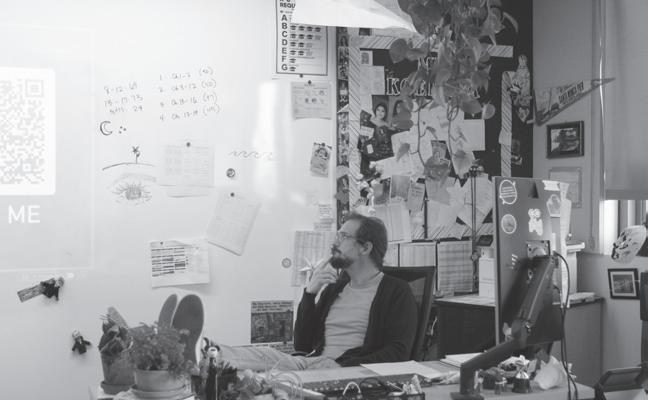
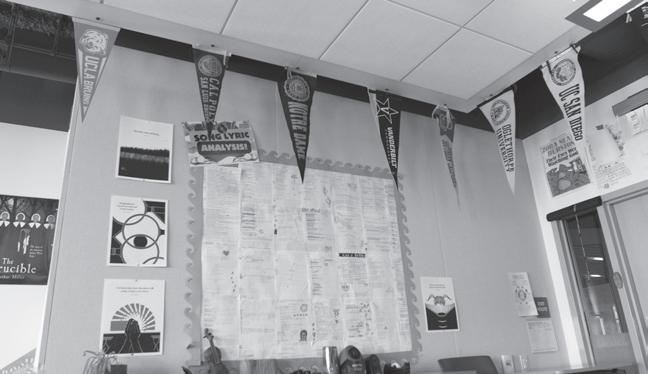


Across campus in the Discovery building, AP Lit teacher Pete Barraza shared his aim to stage his admiration for previous students’ artwork pieces for essays and projects they worked on.

“I like cats a lot. Over the years, I’ve had students give me cat artwork that I put all over the walls,” Thun said. “A student was inspired by a video I showed in class about a cat that had its brain surgically altered. The video was about an experimenter who removed part of the pons (structure in the brainstem), making it so the cat acted out its dreams.
Within the presence of photographs everywhere, photography teacher Martin Ledford shared the meaning behind his wall of letters.

“I have a personal wall that means a lot to me. There are nice thank-you letters for being their teacher. On days that are difficult, I like to look up there and remind myself that people got something from the classroom,” Ledford said. “That’s really helpful because some days can be low, so it’s a nice way to remind myself I can have good days.”



“I put up students’ artwork as a way of honoring them, and it’s kind of like a response to the literature we’ve read in class. So many of these pieces have been remarkable displays by students over the years,” Barraza said. “It’s a reminder for me to show students what great pieces come from their investment and their readings that art can come in different forms. I think students see that the literature extends beyond the classroom and to other types of art.”



In the talk of having a wide selection of syrup flavors for a hot cup of coffee, AP US History and AVID teacher Margaret Colburn shared the purpose of all the colorful decorations plastered on the walls.

“I have an AVID team, so that’s why I have college banners. To make it avidy, I have a ballon celebrating where people are going. On the other hand, we have history, so I have famous people in history. I’ve got plenty of history memes and a map,” Colburn said.
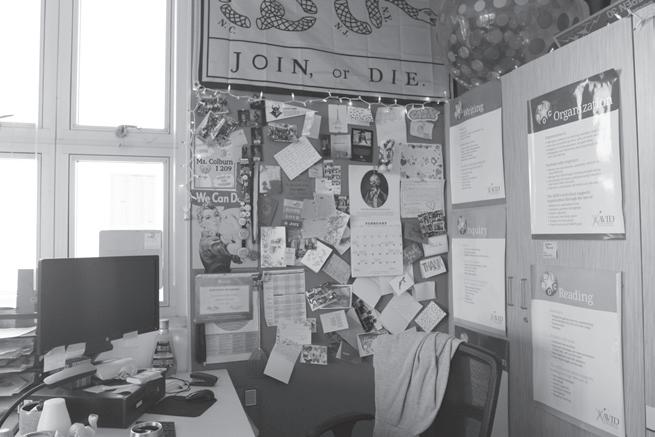
While having an emotional supportive momentum to keep striving toward, Ledford also shared his philosophy behind the camera of the Polaroid. “I have a wall of Polaroids of students which they like. They love seeing the prints, the physical part, and the analog. The camera becomes universal regardless of where you are in your life. Emotionally or educationally, photography is its own language,” Ledford said.
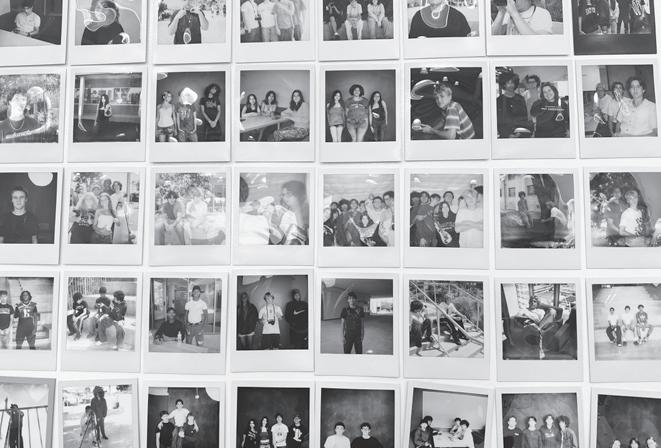
Creativity buzzing around, Colburn shared her journey of progressing her classroom to be what it is today,
“I like a lot of color and fun, so this year, I decided to add the patriotic lights. So I have red, white and blue colors around the room,” Colburn said. “The coffee station was started by Alana Ross in AVID, during my second year teaching, and she asked me to set up the station and a punching bag, and I said okay.”


On Feb. 17, the seniors began their game of senior assassin- attempting to spray each other with water to “assassinate” a target given. The plan was implemented by an Instagram account, @samohi2025assassin, which used the platform to spread the word and organize the seniors. To play, a senior must pay five dollars to get their name added and submit a photo of themselves. The seniors were then given a target to find and spray with water. The targets switched every two weeks and everyone joined a site to keep their locations on so the assassins could know where their victims were. The eliminations could only happen off campus, before or after someone’s employment hours and outside of sports practices and tutoring. One’s own house was a haven as well unless let a family member. Physical ct and non-water blasters and orbeez were banned after vote. @samohi2025assassin, the nator, said they were excited about
“I was talking to my friend on the weekend about how no one was running it and I just decided I would,” @samohi2025assassin said. “It was pretty difficult at first trying to keep track of who paid me and trying to get photos from every single person. But frequent story posts and Google Sheets helped manage it easier.”
practice. I had my last target’s address, so it’s like if you know who to go to, you’ll get all the information you need.”
Dalyla Cunningham (’25) also used a telephone game to find her information. She also believes that sportier players will win, especially those who are more serious.
“I feel like [the winner] is going to be like a guy who’s intense about it,” Cunningham said. “Maybe some kind of sport or something like that. There’s some people that I feel like would take it really seriously and fully run after people and stuff.”


There were also safety items put into place that changed every two weeks, such as goggles and fanny packs - where a senior must be wearing their safety item to be counted as safe and unable to be eliminated. The eliminations must also be filmed, with the target visible- during or after the splash- or the target must admit to getting terminated. A twist the coordinator added was purge rounds, in which every Friday, everyone participating would be allowed to eliminate anyone they wanted to, regardless of target status or not. @samohi2025assassin discusses how the word spread.
“We are at around 300 players currently,” @samohi2025assassin said. “Instagram helped spread information to the majority of players, but I heard a lot of people talking about it at school.”
Nayeli Lopez (’25), a senior participating in the assassination, said she finds it more entertaining due to the questioning of who has who and the possibility of sudden elimination. She believes that coming to school is much more rewarding now that such chances exist. Lopez describes how she attempts to find and assassinate her targets, especially in such a large school.
“I ask my friends if they know my target,” Lopez said. “Or I’ll try and ask their friends. Typically, we kind of know a lot of people, so I’ll get their schedule and I’ll figure out whether or not they have
The top five assassins are Luisa De Lorenzo (’25) with seven kills, Blue Hunter (’25), with four kills and Sabrina Livingston (’25), Ben Defranco (’25) and Steven Petramale (’25), all with two kills. As of this moment, the game is continuing, with the competitors slowly dwindling and the energy becoming more competitive. Cunningham discusses her opinion and the way both seniors and non-seniors have interacted with the senior assassin game.
“I like it,” Cunningham said. “I think it’s fun to have something to do, just because I feel like recently there haven’t been that many activities and stuff. It’s kind of nice to have something that all the seniors are involved in. From what I can tell, the seniors are taking it kind of seriously. For the rest of the school population, I can’t completely say, but I have a few junior friends who seem kind of interested in what’s happening. So I guess for them it’s also like something to hear about and something entertaining.”
thesamohinews@gmail.com
Alisa Ignatenko
Staff Writer
Undeniably lush, exotic and alluringly sinister, “ e White Lotus” has returned to Max for its third season. For lovers of dark humour, clever social commentary and suspicious characters, the overdone depiction of the obnoxiously wealthy, chaotically beautiful scenery and fresh mimosas clearly sanction this melodrama as the next watch. Each chapter takes place somewhere new—Hawaii in season one, Sicily in season two and the captivating but extremely tense atmosphere of ailand in the newest season. e “White Lotus” resort is meant to act as a sanctuary for its guests, though it’s anything but restful.
In the second episode of the new season, the guests are accommodated on the island.






Olivia Stephansen Social Media Editor


Dreamy montages give a glance into the e ort of maintenance of the hotel. Piper Ratli comments about the appearance of the hotel to her parents.


e very rst scene starts o with a bang, literally. At the resort, an unidenti ed young man is meditating with his instructor, and gunshots are heard. e two run separate ways and it follows the young man hiding, and praying that his mom is safe, wherever she is in the resort. en it transitions to a week before the incident, and it is now a matter of time to see the lead up of events that result in the shooting. is production explores the gruesome side of wealth, and complicated relationships taking place in a luxurious resort. Season three introduces a whole new cast, besides a couple recurring faces. A trio of extravagant middle-aged women (Carrie Coon, Leslie Bibb, and Michella Monaghan) who are lifelong “friends” bring hushed gossip sessions supported by numerous bottles of overpriced wine, adding an addictive, passive aggressive element that makes it hard to hit pause. Who could forget about Chelsea (Aimee Lou Woods) and Rick (Walton Goggins), a couple with a curious night and day dynamic. Woods’ character is an optimist, while Goggins’ is perpetually annoyed; their banter is so awkwardly conducted, but just as thought-provoking. Creator Mike White mastered the uncomfortable bond that will hopefully pander to the sheer absurdness of it all, but also cater to the most vulnerable intricacies of a relationship.
Whether it is a bold lip, natural glow, or heavy eyeshadow makeup empowers people to embrace uniqueness and fosters self-expression. While new trends are constantly evolving in the beauty field, makeup should be used as a creative tool rather than a constrictive standard. Makeup is art, something that allows individuals to grow into themselves and showcase their personality. Makeup can break traditional beauty standards and can be used for personal empowerment, not as patrion for patriarchy. Everyday it can be seen that Samo students use makeup as a form of expression and are very talented in doing so.












“It’s like a Disneyland for rich bohemians from Malibu in their Lululemon yoga pants,” Ratli says. e family goes through their rst wellness treatments, all unsatis ed in their own ways. Victoria said her massage made her anxious, therefore, she takes another tranquilizing pill; her character has been abusing pills at every opportunity of distress. Saxon, who grapples with some toxic “my way or the highway” mindset, is upset that his massage didn’t go hand in hand with his expectations. e father, Tim, gets a call from an old colleague, Kenny, warning him that he will soon be caught for a money laundering scheme played o years before. e characters are written brilliantly, so accurate to everyday people, but still interesting to watch.
e childhood friends Laurie, Jaclyn, and Kate are discussing potential mates at the resort, as well as making snide comments towards each other’s body fat percentage. eir deepest conversations equate to a middle school girl’s sleepovers; it is as if they are waiting for the rst person to fall asleep so they can nally talk behind their back.


Shi ing focus from the nonmarital, a family of ve is unveiled: the Ratli s. Featuring a vapid presenting mother (Parker Posey), and boasting “alpha male” father (Jason Isaacs) with three kids in di erent teenage stages. e oldest son, Saxon (Patrick Schwarzenegger), is 19 and shows to be a little too self involved while the 16-year-old, Lochlan (Sam Nivola) proves to be the opposite, presenting as quiet and withdrawn. Yet, the 17 year old daughter, Piper (Morgana O’Reilly) stands out; even though the family’s trip is to celebrate Piper writing her thesis, there’s


a collective underlying resentment towards her. A potential reason is that Piper is supposed to be interviewing a monk for her thesis, but never really seems to take any action into making progress, despite presenting herself as being very invested. e real star of the show is music composer Cristobal Tapia de Veer. e eerie yet atmospheric soundtrack is all thanks to him, tailored for every twisted moment. Starting o with a somewhat soothing tune, it matures into one that feeds a river of worry for what will happen next. Bewildering shots of ailand’s serene landscape, combined with the music, provide an unbearable sense of anticipation mixed with a skewed harmony.
Jon Gries returns as Greg, which is like a car crash that nobody can manage to look away from. He was a malicious, gold-digging husband in the rst two seasons and is now deceiving another new woman in ailand. Gries e ectively puts everyone on edge with his o -putting demeanor and his aggressive hairlessness. He helps bring the show that almost intentional discomfort, maintaining his level of unpredictability.








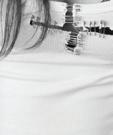

e couple, Chelsea and Rick, are business as usual so far with Chelsea trying to bring some life back into the dismissive Rick. Curiosity is rising to see how things unravel for the travelers.

e third episode opens with an uncanny sight: the Ratli mom, Victoria, is shown holding a pill bottle, presumably the one she takes every day. ere is a blue haze, and it is obvious this is set in her dream. With the dark color scheme, she is engulfed in blankets by hotel sta and stands in front of her house in America, a tsunami brewing. Soon a er the scene, she discusses the dream with her family, and Piper brings up tsunamis as warnings in dreams. It’s clear that her nightmare is meant to allude to her husband’s legal issues, which she and the rest of the family have yet to know about. ese unnerving instances reappear throughout the whole episode. One of the three girlfriends, Kate, admits to being a Trump supporter and is subtly shunned by Laurie and Jaclyn. e biggest “Oh my god” muttered was watching Greg get recognized by one of the transferred Hawaiian sta from season one, Belinda (Natasha Rothwell). He shadily brushed her o and le , even though she knew he wasn’t who he claimed to be. It’s clear that by episode three, all the visitors emit total anxiety. e fourth episode reveals a lot of things that have been pondered over the week. e Ratli family’s legal issues are still clouding the air, and are only getting worse. Greg, or now Gary, has o cially been discovered by Belinda, who put the pieces together that he killed his wife for her money in season two. All the big secrets that had been fed so far were debunked, and Rick nally confesses his reason for coming to ailand. Season three of “ e White Lotus” is an absolute must-watch. e show continues to solidify itself in the industry with its cutting-edge commentary on privilege, relationships, and overall human nature. is season is as addictive as the last, if not more so. It’s a beautifully disturbing turn of events that is nearly impossible to stop watching. Not thriving in ailand? Watch something that’ll make anyone feel like they’re right there, tanning with the trustfund nihilists.






“Makeup helps people feel better about themselves and I think it makes them stand out. It is an art form because people do cool makeup and I love to do random things. My favorite trend is 2016 eyeshadow because I love it so much and doing contour.”
- Anika Sarvey (’26)


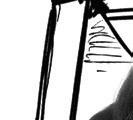











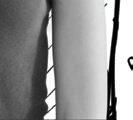

“ Makeup is an art form because even though it is something you do every day there is also so much more to it, as it’s almost like sculpture, like drawing- if drawing is seen as an art I think makeup also should be. My favorite makeup trend is brown eyeshadow (wings) mostly on the eyes, since it makes them pop and stand out”.
- Florence Fraser-Macduff (’28)


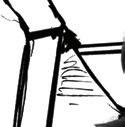



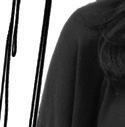









“I think makeup lets people express themselves, sometimes I see people put fun colors on their faces and it makes them have more fun. I feel like makeup is an art form that’s why I do it, it’s similar to when I paint because it’s very relaxing and therapeutic. My favorite makeup trend is doing brown eyeliner because it’s the most fun.”
- Stella Vegezzi (’25)
Athena Barefoot Staff Writer
e Oscars are supposed to be the ultimate celebration of lm—the night when the lm industry’s biggest talents are recognized, careers skyrocket and unforgettable moments are made. But in reality, the Academy Awards, despite all their glitz and glamour, don’t always get it right. While this year’s ceremony had its highlights, it also had its fair share of snubs, overlooked masterpieces and the usual Academy’s frustrating refusal to embrace the lms that actually matter to a lot of young people.

e 97th Academy Award took place on March 2, 2025, at the Dolby eatre in Los Angeles, hosted by Conan O’Brien. e evening celebrated the past year’s biggest achievements in lm, with some obvious and deserved wins and some brutal losses. Anora emerged as the night’s biggest winner, taking home ve Oscars including Best Picture, Best Director for Sean Baker and Best Actress for Mikey Madison. Adrien Brody won Best Actor for “ e Brutalist”, while Zoe Saldana made history as the rst American of Dominican origin to win Best Supporting Actress with her role as Rita Mora Castro in “Emilia Perez”. But beyond the trophies, there were also some great moments like Adam Sandler casually showing up in gym shorts (of course) and Morgan Freeman giving a heartfelt tribute to Gene Hackman who passed away last month. Yet even with
these standout moments, the Academy’s usual blind spots were impossible to ignore.
Every year, there are lms that critics, fans and social media obsess over, only for the Oscars to act like they don’t exist. 2025 was unfortunately no di erent. “Challengers”,



of work where certain images will be eternally burned into your mind and the feelings it exudes will linger far a er the credits roll,” but apparently that wasn’t enough to be recognized by the Academy.

















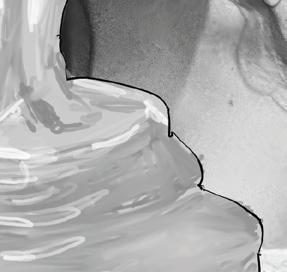

starring Zendaya, had people talking for months because of its intense performances and unique storytelling, but the Academy didn’t even nominate it. “I Saw e TV Glow”— a surreal and emotional take on identity and teenage alienation—was another lm that resonated deeply with audiences. Its visuals and LGBTQ+ representation struck a chord for so many people, and yet, it got absolutely nothing from the Oscars. FilmStage described it as a “towering achievement of total artistic freedom, the kind


And then there’s “A Complete Unknown”, the Bob Dylan biopic, which went zero for eight on the night. is is now the second time in three years that a lm about a music legend was completely shut out, “Elvis” also lost all eight of its nominations in 2023. Both times, actors who were considered frontrunners for Best Actor le empty-handed. Chalamet at least got to celebrate “Dune: Part Two” winning multiple awards, but still, it is frustrating that the Academy keeps ignoring music biopics unless they t a super speci c mold. How does a movie about Bob Dylan, one of the most in uential and loved musicians ever, not win a single award?
Despite all the snubs, the Oscars still matter… for now.
Winning one can change a lmmaker’s career, and the ceremony still sparks conversations about the future of movies. But if the Academy wants to stay relevant, it needs to wake up and start recognizing the lms that actually make an impact on audiences beyond just the critics. Right now, the best movies aren’t always the ones taking home the gold, and that’s a problem. If the Oscars want to continue being a celebration of lm, they need to start celebrating all of it.
Alisa Ignatenko Staff Writer
lucre,” Dean Blunt’s new EP released on Feb. 7, feels like eavesdropping on something not meant for you, but something you feel you deserve to know. Listening to the album from start to nish, it’s clear the songs aren’t made to be listened to in order. Blunt’s lyricism and gritty vocals evoke an unspeakable nostalgia. It is strikingly mood heavy, and more whole than his previous songs and albums with a more coherent melodic structure. In the entire album there’s barely any vocal manipulation, just a sense of foggy distance in the music. Each verse has a little something for everyone, whether that’s thoughtful lyrics or comforting acoustics, at least one track is bound to resonate. Blunt’s last album, “BACKSTAGE RAVER,” has not gotten as much recognition in the mainstream as his most beloved album, “BLACK METAL,” released almost 10 years ago–here’s to hoping “lucre” gets its due diligence. Blunt collaborated with Danish vocalist Elias Ronnenfelt to create this cryptic piece, and disregarding the mysterious rst impression, they managed to convey an unspeakable tenderness. Another notable and well-received track is “5” which starts o with whimsical strums of a guitar, and immediately dunks you into his



angsty yet loveable lyrics. Blunt uses lyricism as a tasteful declaration of his angst.
“Since it’s been gone I’ve been lookin’ for anything, since I’ve been lyin’ I don’t mean a thing I say” is style of songwriting is one size ts all, no matter what music taste the listener

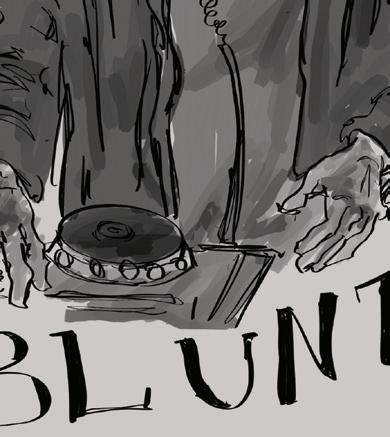

“lucre” is brilliant and understated. Blunt’s popular songs like “9” or “LUSH” have simple lyrics, but In contrast, tracks from “lucre” are tediously craed. ey are a testament to his ability to create an incredibly immersive listening experience, and continue to not rely on conventional song structures.
lucre” showcases his artistry at its rawest and intentional point. In his song “3,” Blunt documents his disdain for a rudimentary, pedestrian lifestyle.
“I’ve been locked down running errands, I would get vile for a table… Kicking bricks around the goddamn road.”
He embarks on a vendetta for his feelings of stunted growth and shame. With the release of the new album he continues to step in his dreamy, cloud-like footsteps and continues the pattern of numbering his songs instead of naming them. Blunt has once more managed to pull listeners in with a deeply personal and deliberately elusive experience.




Chicago is truly, all that jazz
Samo eater’s performance of “Chicago” by Bob Fosse and Fred Ebb perfectly encapsulated the musical’s iconic energy and bold acting. From Feb. 28 to March 9, Barnum Hall was alive with the intoxicating sounds of “Chicago.” As the curtains rose,

the audience was swept away into the lively jazz scene of the roaring 20s. “Chicago” follows Roxie Hart (Leah Boumel (’25) and Juliett Rojas (’25)) in her journey navigating through Cook County Jail a er murdering her lover, who attempted to break o their a air. Roxie creates a erce rivalry with vaudeville nightclub star, Velma Kelly (Celine Hutchinson (’25) and Chloe Senior (’25)) a er stealing her shining spotlight. Both are represented in court by Billy Flynn (Walden Sullivan (’25)), who turns the girls and their trials into a high-stakes media circus.
e strong vocals of Samo eaters actors and actresses captivated the audience as they brought each of their ashy characters to life. Sullivann stunned the audience during his performance of “All I Care About is Love” and “We Both Reached For the Gun,” e ortlessly holding exceptionally long notes that earned him hollers and cheers from the audience.
Duets of “My Own Best Friend” and “Nowadays” between Boumel and Huctinson and Rojas and Senior, beautifully blended both girls’ vocals and con icting emotions, heightening the tension in a rivalry that may come to an unexpected shi . Rojas discusses her connection to her character.
“I’ve always admired the lm Chicago, and I love the character Roxie because I see parts of myself in her” Rojas said. “She’s this quirky character, and people may perceive her as a dumb common criminal, but she has so many layers behind her”
e Merry Murderesses took the stage and captivated the crowd in their de ant performance of “Cell Block Tango.” Each murderess unapologetically retold her story of the man she killed, powerfully and ferociously asserting why “he had it coming.”
Led on stage by associate choreographer Isabella Salem (’25), the featured dancers of “Chicago” moved throughout the the-
ater with exceptional precision and truly brought the sassy style of the show to life with dynamic choreography and stage presence.
“I loved performing ‘All at Jazz’ because it opened the show and set the tone for the rest of the performance. Fosse is a very speci c style of dance, so I tried to incorporate di erent movements that would re ect that Fosse style without directly taking from the Fosse foundation,” Salem said.
Whether in a dazzling red or gold dress, a sharp pinstripe suit or sleek black-andwhite prison attire, each costume was an impeccable re ection of the “Chicago” theme. e glamorous wardrobe of each character encapsulated the roaring 20s and the chic yet rebellious nature of the era’s fearless and ambitious gures. Complementing the costumes, boldly styled hair and makeup made each actor pop on stage and enhanced each of their larger-than-life personas.
Along with skillfully executed set design, lighting, props and music, each and every crew member working backstage contributed to making “Chicago” a remarkably

seamless production. is show immersed the audience in the glitz of the Jazz Age while highlighting the gritty underworld of corruption and crime. Ella Lee Ever-Hadani, a member of the costuming team, shares her experience working behind the scenes.
“We have a mood board where we compile reference photos of di erent performances of ‘Chicago’ like from the Broadway show or the movie which helps when thinking how to plan the performance,” Ever-Hadani said. “To make the costumes 1920s we added a lot of accessories, big jewelry and lots of feathers and sequins leaning into the showy and amboyant side of ‘Chicago’”.
e closing performance of “Chicago” on March 9 set a record for Samo, with the largest audience out of any production held in Barnum Hall. As the curtain fell that night, the packed theater burst into applause as every student, sta member, and parent that contributed to the creation of the show celebrated the
Ryan Colvin Staff Writer
On Feb. 2, 2025, the Los Angeles Lakers sent shockwaves through the sports world after landing Slovenian Superstar Luka Dončić in a blockbuster trade with the Dallas Mavericks which sent all-star forward Anthony Davis the other way. Mavericks general manager (GM) Nico Harrison, amidst immense backlash from fans after trading their franchise cornerstone, believes that bringing in a top-tier rim protector in Davis is a win-now move. For the Lakers, GM Rob Pelinka took a gamble on a generational talent that will alter the outlook of the franchise for years to come. Harrison’s main concern with committing to Dončić was his physical condition, but most saw him as untouchable due to his elite level of play. Despite exceeding the Mavericks’ ideal weight class by 35 pounds, Dončić had a historic 2024 season, leading the league in scoring (33.9 PPG), ranking first among guards in rebounds (9.2) and second in assists (9.8). His ability to draw in defenses gives the Lakers an immediate lob threat and a plethora of pickand-roll weapons. Dylan Michelini Jackson (’27) shares his expectations on Dončić’s impact. “It utterly shocked me when I heard about it,” said Michileni-Jackson. “I couldn’t believe it. He’ll work so well and flow so evenly with the Lakers’ offense. His on-the-court IQ is so insanely high that it will be a perfect match with Lebron’s veteran knowledge. The Lakers are definitely gonna be a team to watch out for in the playoffs.”
Dončić got off to a slow start in LA, averaging just 14 PPG in limited minutes, but a statement win over the Denver Nuggets saw him flourish for the first time post-injury. In his first unrestricted game, Dončić produced a 32-point near triple-double. More importantly, the mismatches he created offensively helped the Lakers to steamroll their way past the team that has been their Achilles heel since the turn of the decade; in fact, the Lakers had lost 13 of their previous 14 matchups with the Nuggets. The main criticism of the Lakers following the trade was the fact that they lost their toughest defensive presence in lieu of Dončić, a perennially lackluster defender, but the performance in Denver seemed to alleviate these worries. With a much smaller and more flexible lineup, the Lakers were in constant rotation guarding back-toback MVP Nikola Jokic in the halfcourt, scrambling to double-team and negate his lob threat whenever possible. Even Dončić was switching effectively, helping hold Jokić to just 13 points and six turnovers in his worst game of the season so far. On the other end, Dončić appeared to return to his sharpshooting self, hitting stepback threes and barking at defenders along the way. Dončić proved to be a nightmare to defend one-on-one, yet swarming him is a risk due to his exceptional playmaking. Pair that with the veteran leadership of LeBron James, and you have a free-flowing, constantly evolving system that only has room to grow. With Dončić, it isn’t just about his individual talent; he elevates his teammates to the next level. The Lakers have the highest defensive rating in the NBA across their last 15 games and have won 20 of their last 25 to jump to third in the Western Conference. Roen Peralta (’25) gives her insight on their championship potential.
“If Luka keeps up the same kind of momentum he created in that Nuggets game, I think we have a good shot [at the title]” Peralta said. “The Mavericks represented the west in the finals last year with Luka at the helm; now Luka is running our ship along with the experience of LeBron and our exciting younger core. I think the rest of the league should be scared.”
Art by Raha Ghoroghchian

thesamohinews@gmail.com

Leo Lucente Staff Writer
68 teams, six rounds, one winner. This year’s March Madness begins on March 18 and will crown a champion on April 7. The single-elimination college basketball tournament is an American establishment and has acted as the national championship for the National Collegiate Athletic Association (NCAA) Division 1 College Basketball since 1939. Last year, a combined nearly 34 million viewers tuned in to the finals of the men’s and women’s tournament. Based on regular season play thus far, the Duke Blue Devils and Auburn Tigers are the top favorites to win the men’s tournament. As of late February, these schools were the only two teams that had negative odds in the money line to make the Final Four. Duke, led by New Balance-sponsored 6’9” guard, Cooper Flagg, will seek to win their sixth NCAA title and first without famed college coach Mike Krzyzewski or Coach K, familiarly. Flagg made headlines this past summer for holding his own in practices with the Olympic champions of Team USA and, if he declares, will likely go first overall in the 2025 NBA Draft. Other top teams in this tournament are the University of Florida, the University of Alabama and the University of Houston. The Alabama Crimson Tide have been averaging over 90 points on offense a game, the most in the NCAA, while the Florida Gators have taken down Auburn and won three straight. A notable name missing from the list of top favorites is Dan Hurley’s University of Connecticut (UConn). After winning back-to-back titles in 2023 and 2024, Hurley turned down a six-year, $70 million contract with the Los Angeles Lakers to chase a three-peat with UConn. While the UConn Huskies still qualified, they will enter the tournament with 40-1 odds to win. In the women’s tournament, which was introduced in 1982 and
has the same format as the men’s, the South Carolina Gamecocks look to repeat as champions from last year. The Gamecocks’ Chloe Kitts and MiLaysia Fulwiley will have to hold off red-hot University of California Los Angeles (UCLA).
Led by Gabriela Jauqez, sister of Jaime Jaquez Jr., a graduated UCLA star, the Bruins have gone 26-1 in their season so far and show no signs of slowing down. Isaiah Fernandez (’26), however, predicts their rivals, the University of Southern California (USC) Trojans to take home the title.
“Juju Watkins is balling. I think USC has a pretty good shot. UCLA is doing really good too, but I don’t know,” Fernandez said. “I think USC is gonna take it this year.” Fernandez made picks for the men’s tournament as well.
“I think Duke is looking pretty good. They always look really good but especially this year with Cooper Flagg, generational prospect,” Fernandez said. “I think Auburn looks really good as well. I think Duke or Auburn is gonna take it.”
Of the 36 teams who have won the men’s tournament, UCLA has the most titles with 11. On the women’s side, UConn has the most titles with 11 as well. Coincidentally, Samo varsity basketball player Zach Bennett (’26) predicts UCLA to win the men’s tournament and UConn, the women’s.
“I think UCLA will win,” Bennett said. “They’ve got a good team, they have heart. I like Trent Perry too because he’s from around LA and went to Harvard Westlake.” March Madness is infinitely hard to predict. Since 2014, Warren Buffet has offered $1 billion to any of his employees who can submit a perfect bracket. Berkshire Hathaway employee or not, no one has ever predicted the entire tournament correctly. The tournament is full of upsets and nonstop, entertaining chaos.
thesamohinews@gmail.com
Samo boys varsity soccer enjoyed a near flawless 2024/25 campaign, going a perfect 9-0 in league and becoming league tournament champions. Their undefeated season secured a spot in the CIF Southern Section Open Division, where they dramatically beat Crossroads 3-2 on aggregate. After a 1-0 home victory, D1 recruit Gabriel Sherman (’25) scored both goals for Samo in the second leg to propel the Vikings to a historic semifinal against JSerra Lions, the top ranked school in the United States.
The first leg ended in a hard fought scoreless draw, and the Vikings came out firing in the second leg. Khaelon Zeitlin (’26) expertly dispatched a penalty before Orlando Popkin (’25) bundled home the second from close range. The Lions pulled one back at the end of the half, sending the Vikings into the break up 2-1 on aggregate.
JSerra came out with a newfound intensity in the second half, forcing goalkeeper Pedro Duarte Silva (’25) into a handful of excellent saves. The Lions slotted home the equalizer after the hour mark, before centre back Ben Komlos (’25) saw his second yellow of the night on the ensuing kickoff and was sent off. Down a man, the Vikings defended valiantly through the end of full time and both extra time periods.
In the 110th minute, JSerra blasted home the golden goal winner with the last kick of the game. Following the heartbreaking result, co-captain Asa Colwell (’25) provided his thoughts on the performance.
“We really held up in the first game, we were really, really strong against the number one team in the country,” Colwell said. “The second game, unfortunately we lost, but still we showed great resilience.”
Despite the desolating loss, Samo still managed to earn themselves a spot in the State Regional Competition. On Tuesday, March 4, Samo traveled to San Diego to face the St. Augustine Saints in the first
round. Senior Leon Ivanov (’25) opened the scoring with a beautifully placed header, before a penalty for the Saints took them into halftime locked at 1-1. In the second half, Sherman restored the advantage for Samo, taking his tally for the season to a staggering 12 goals and six assists. With the Vikings taking a 2-1 lead into the closing stages, St. Augustine was awarded their second penalty of the game in controversial fashion. The Saints pulled level once again, sending the game into a penalty shootout. Samo lost the shootout 5-4, ending their deep postseason run with back-to-back agonizing defeats. Colwell speaks out on how the officiating affected the outcome of the game.
“Everyone agrees that it wasn’t a penalty. The actual guy that got fouled went over to his teammate and said he kicked the ground,” Colwell said. “It’s just such an unfortunate loss and it feels like the officiating could have been better, but it’s in the past now. I feel like we displayed some amazing soccer over this past season, and we had a great CIF run. I am so grateful for all my teammates and all the boys out there; I feel like we worked hard and we didn’t deserve to lose, but I’m very happy.”
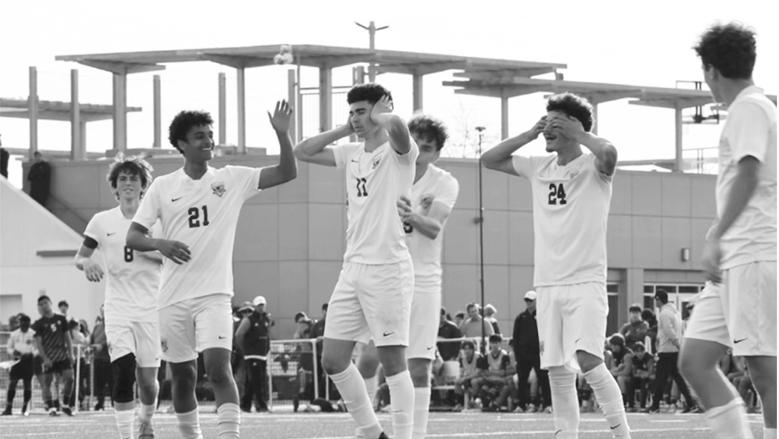
thesamohinews@gmail.com
On Feb. 21 and Feb. 22, Samo wrestling players Arata Sakamoto (’26), Fred Ekberg (’25) and Kenji Ineno (’25) competed in the Masters at Sonora High School, which takes place one round before State. During the season, players competed in a series of tournaments, which were then followed by league finals held at Samo on Feb. 8. The top three players in each weight division qualified for CIF finals, which took place at Mira Costa High School for the boys and San Dimas High School for the girls. In the girls’ league, the top eight players qualify for the Masters meet, and for the boys, the top five qualify for the meet.
Reaching Masters has been a long term goal for these players, and through much hardwork and determination, a few were able to achieve this goal, including Ineno.
“I have been wrestling since the summer of 8th grade,” Ineno said.
“It is not something that you can get good at overnight, it takes years of hard work and dedication, and staying committed over these past few years has helped me so much to get to where I am today.”
Being focused both at school practices and outside of them was also a large component in the players successes, including Ekberg’s.
“My success had a lot to do with the wonderful coaching staff, but I also went to a lot of clinics and club practices at Cerritos Community College,” Ekberg said. “Putting in extra work definitely helped, but a lot of it was done here at Samo.”
Although none of the players qualified for state, Masters was still a growing experience for
wrestlers. Ekberg touches on the challenges as well as the victories it presented.
“It [Masters] was really tough. It obviously was a very big dream of mine to get there, but in the first round, I got the guy who was ranked nationally number five at my weight class. I got my ass beat, and then I got a very nice win,” Ekberg said. “It was really special to get to share that moment with my teammates. They were all cheering and emotionally, it was just overall an extremely nice experience.”

Eugene Naruse Staff Writer
Samo kicked off the swim season this year with a win in their first meet against Venice and Cleveland on Feb. 26, following a successful prior season. Last year, the girls’ and boys’ teams went through to the CIF-SS preliminary round for the 4x50 freestyle relay, with the girls’ team further advancing to the CIF-SS finals. Individually, Samo also sent multiple swimmers to the CIF-SS preliminaries, in which some also advanced to compete in the CIF-SS finals.

While they didn’t achieve their desired victories in the CIF finals, head coach Matthew Flanders looks forward to improving and continuing their success for the new season.
“We are getting stronger every year and hopefully, we will place higher in the league rankings and CIF,” Flanders said. “I think the girls can make a real run in the league and CIF this year with Daniela Petran (’25) and Gabriella Gooden-Brito (’28) leading the way.”
Petran, thought to be a key player by Flanders, hones in on what it will take for Samo to have a successful season.
“I think this year we can improve and focus more on our relays and team aspect because a lot of last year was focused on individual events. I hope to make it back to states again this year, although I suspect with our current team we can make it with relays and individually. But I would definitely like for us to win CIF’s,” Petran said.
Brito, who also competed and qualified in the Olympic trials last summer as the youngest swimmer there, talked about her goals for this season.
“I hope to get a lot of records and obviously go to states and CIF. Most of all, I just want to have fun and hopefully we can get Samo to D1 next year because we are at D2 right now,” Brito said.
Samo’s first meet was held on Feb. 26 against Venice and Cleveland High School at the Drake Pool. Dominating in multiple events and relays, both the girls’ and boys’ teams won the meet with their combined score tallies.
Jackson Colby (’25), the team captain for the boys’ swim team this year, stood out in the first meet by finishing 10 seconds ahead of the others in the 500 Yard Freestyle.
“We’ve been doing great so far, and we hope to get more players to qualify for CIF this season,” Colby said.
Some Samo swimmers also competed in the South Bay Invitationals held on March 5 and March 7, with the girls’ team finishing third out of eleven schools and the boys’ team finishing fifth out of ten schools. Samo shined in their relays, with the girls finishing second in the 200 Yard Medley and 400 Yard Freestyle Relay, third in the 200 Yard Freestyle Relay, and the boys finishing fourth in the 400 Yard Freestyle Relay. Individually, several students also finished high in their categories, including Paloma Kimura (‘28), Sloane Bryant (‘26), Brito and Petran.
On March 12, Samo also faced Peninsula and Palos Verdes in an away game, with upcoming meets against West Torrance on March 20 and El Segundo on March 27.
thesamohinews@gmail.com
Dalia Puchalt News Editor
Despite their recent league switch, the Samo boys’ golf 2025 season is off to a strong start. Samo’s smallest varsity team had their first match on Feb. 26 against Malibu High School at the Vikings’ home course in Rancho Park, winning by 55 strokes with a final score of 204 to 259. The team played Culver City High School on March 4 as well, ending with a winning score of 218-239 at Alondra Park Golf Course despite winds reaching 20 miles per hour. Their second match against Culver City High School—this time at their home course on March 6—was also a success, as they secured the win with a final score of 203-265 strokes. Last season, the Vikings ended strong, placing third in the Bay League with five players qualifying for league finals as individuals. Still leading the team is Head Coach Bart Burdick and Captain Luke Khosla (’25), the team’s sole senior and captain of three years. Khosla reflected on their per-
formance last year with pride, remarking on golf’s unique ability to highlight both the player and the team.
“It was sweet to see everyone compete for themselves to represent our school at league finals, because we can compete as a team and as individuals at the same time,” Khosla said.
This year, the team is adjusting to some fundamental changes, moving from Bay League to Ocean League and facing off against new schools. Khosla anticipates stiff competition from last year’s champions at El Segundo High School, who the team will play in the final week of the season.
After seeing three seniors graduate last year, the team is relatively underclassmen-heavy this season with one senior, two juniors, three sophomores and three freshmen. Despite the team’s crop of underclassmen, Khosla admires his team’s resolve and is optimistic about the upcoming season.
“That brings kind of a different element to it when you
have all the younger players—especially in golf, which is a super experience-heavy sport,” Khosla said. “It’s a different energy. They’re super ambitious, and I’m excited to see where we go from here.”
Going forward with a promising record of 3-0, the Vikings will face off against Crossroads on March 11 and South Torrance on March 12 and March 13, away and at home, respectively.
thesamohinews@gmail.com

The Samo softball team is ready to take the field, wrapping up their previous season with a record of 16-1-12. As with most other Samo teams, this is the girls’ teams first year competing in the Ocean League, one division lower than their previous Bay League. Despite two losses at the start of the season, the team remains optimistic after their successful last season, and semester of practice.

The team lost their first home game on Feb. 19 against Palos Verdes High School with a score of 3-5. Their other loss was against North Shore High School on Feb. 24, ending in a score of 5-12. Their March.5 home game resulted in a 2-1 win against La Quinta High School, however. This extends their winning streak to six games.
The team has made a big comeback from their initial losses, with victories against La Quinta on Feb. 28 and Jurupa Hills on March
1, during their tournament in Palm Springs. The Vikings’ beat four other schools with scores of 2-1, 7-1, 10-5 and 8-0. These accomplishments proved their dedication to improvement.
When asked who to lookout for on the field, varsity head coach Leigh Campbell highlighted two seniors, who have been playing since freshman year.
“I am particularly excited to see pitcher/catcher duo Drew Vudmaska (’25) and Talia Yermian (’25) in their final season together. The pair has been starting for us all four years and have an amazing partnership that has been crucial in our team’s success,” Campbell said.
With the mix of experienced seniors, Debbie Amezquita (’25), Bella Myers (’25), Avey Thompson (’25), Vudmaska and Yermian.
In the ’23-’24 season, the team was led by two coaches, Jenny Forester and Leigh Campbell. Forester is on maternity leave, leaving the authority to only one coach. According to seniors Isabella Myers (’25) and Ava Armendariz, having one less coach and losing some structure has been weighing on the team this season, while also positively impacting the team dynamic as a result.
“I think this season has been different. Having one coach has definitely made an impact on us, but I think we’re gonna bounce back and be a lot stronger,” Armendariz said.
The team’s next home game will take place on March 18, in their first game against Beverly Hills High School.
thesamohinews@gmail.com
Kamerin Shakir Staff Writer
The Samo boys’ tennis team has started the 2025 season off strong with a 4-1 overall score and an undefeated doubles team. Last season, despite individual successes, the team finished with a 4-8-2 overall record and placed third in the Bay League with a 2-1-1 league record. Their playoff aspirations were impacted by the highly competitive nature of the Bay League, where they started off strongly with a record of 8-0 but eventually lost their streak, making it challenging for Samo to secure a playoff spot. This year, boys’ tennis has switched into the Ocean league, which is one division lower than their previous bay league. With their enthusiastic start, and new varsity singles and doubles additions, the team is optimistic for their first season in the league.

Shaun Simone, the varsity head coach shared why he believes the team was unable to make the playoffs last season and offered his predictions on what’s to come for the team.
“We played the Bay League [teams] twice each so we went zero for eight right off the bat and it’s hard to come back, so we haven’t made the playoffs in the last four years. We might be the Ocean League champions this year,” Simone said.
Top single’s players, Hudson White (’25) and Vincent Cheng (’25), both delivered strong performances, winning all three sets 6-0 in the match against Inglewood. The doubles teams were also able to secure victories in each of their sets, leading to a decisive team win. The team con-
tinued their strong momentum with victories over Buckley on Feb. 20 and Venice on Feb. 27.
However, they faced a 8-10 loss against Windward on Feb. 25. The match began with a challenging start for Cheng, who lost the first set 3-6 but bounced back to win the second and third sets 7-5. As the singles matches continued, Samo experienced a few additional losses. Despite the doubles teams winning 6 out of 9 matches, the team ultimately lost for the first time in the season.
Undefeated first double’s players Levi Title (’25) and Christopher Rhee (’25) shared the changes they made to become an undefeated duo this season.
“We both played singles last season but decided we wanted to play more competitively and go further in the playoffs so we decided to play doubles. We have a lot of chemistry, which helped create our undefeated team,” Rhee said, with Title then sharing their anticipations on the upcoming season, “Deeper in the playoffs we will see a lot of those teams at our level, and hopefully get a chance to score a championship title.”
First singles player Cheng is making his return to the varsity team after stepping away to focus on extracurricular activities after freshman year. Since his return, Chen has accumulated over 50 points, showcasing he’s ready to reclaim his position. Senior captain Jordan Makhani has also been a consistent leader, both on and off the court, stepping in as needed and showing his commitment to the team. Sophomores Audunn Horlick and Gregory Gee have earned their roles as first doubles players, adding to the team’s blend of experienced upperclassmen as emerging talent. With this mix, the team is preparing for a strong season ahead. The team recently won 11-7 against El Segundo, on March 4, and 14-1 on March 6 against Culver City. As of March 10, the team will face Redondo Union, in a non-league match on March 11. Their next home game will be on March 20, against Beverly Hills, with three away games before, against Culver City on March 13, Beverly Hills on March 17, and Inglewood again on March 18.
thesamohinews@gmail.com
Sia Kresch Staff Writer
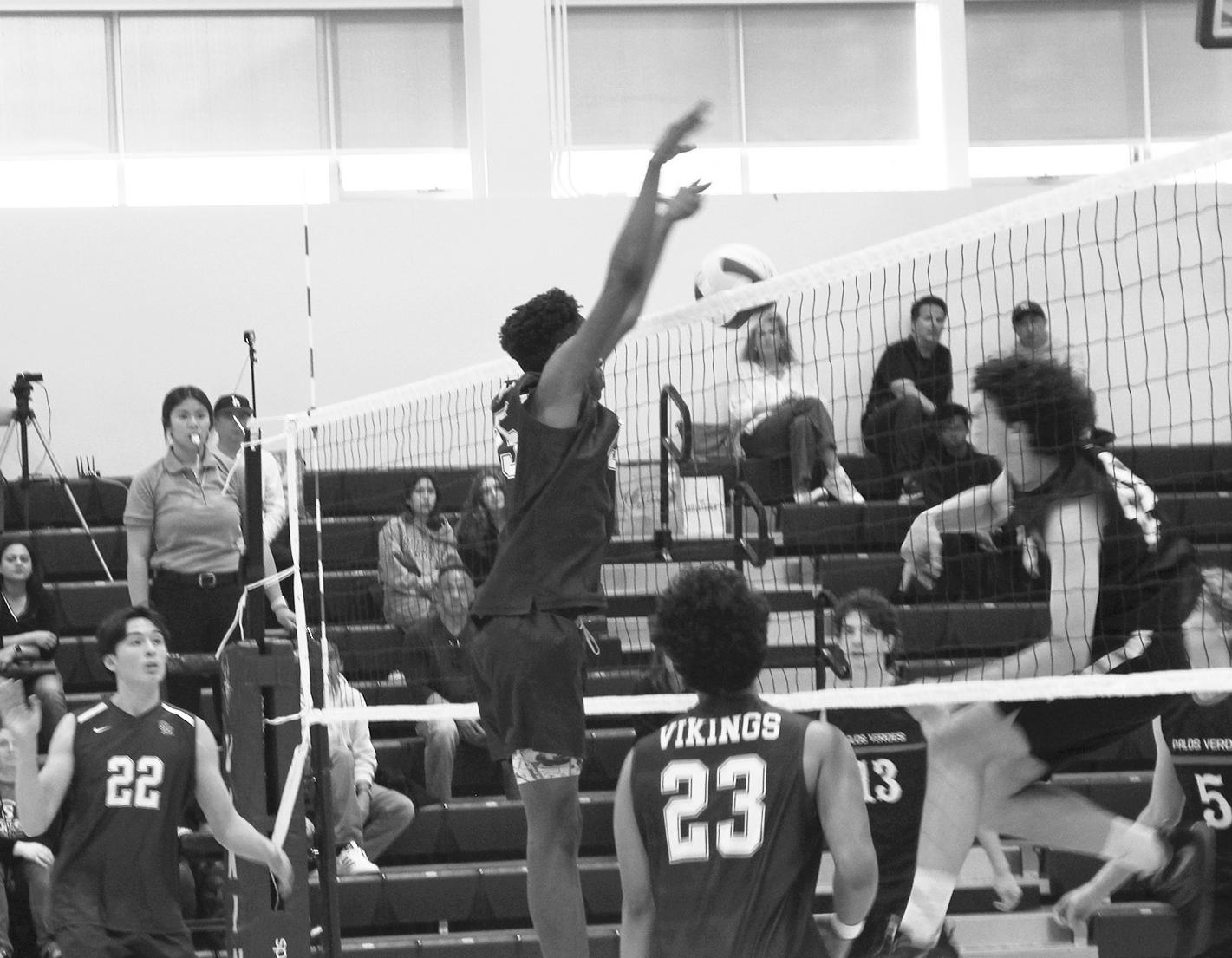
The Samo boys’ varsity volleyball team has kicked off their 2025 season with a strong start, holding a 5-4 record. Although the team lost their first match of the season against the North Saxons, they came back strong winning their home opener against Winward on Feb. 20 by a score of 3-1.
Last year the team experienced some difficulty, landing them fifth in the Bay League by the end of the season. While the game doesn’t change, rosters do; as players have graduated and transferred, new players have had to adapt to competition at the varsity level while also learning how to work together successfully.
“Every team has to have good ball control, be mindful of defensive and offensive schemes, and have the IQ continue to build,” Barraza said. “We also have to look at where the strength of our offense is this year, as it might be a little different, with different players attacking from different places.”
This season, the team has an overall goal of learning and growing together, in order to create the most successful season possible.
“The goal from the very beginning is to give the players an opportunity to find some fruition together, while enjoying the process of getting better playing together,” Barraza said. “They have to learn how to trust each other on and off the court and win or lose, be prepared both mentally and physically to give the team opportunities to win.”
Helping lead the team this season are captains Colin Hughes (’25), Ali Badr (’25), Nathan Jaffa (’25) and Ryne Kapen (’25), who all play a vital role in helping the team obtain their goals.
”It’s like being sort of a role model for the rest of the team, especially for the younger group,” Badr said, “If they need anything, I’m a person that they can look to and that can help out.”
thesamohinews@gmail.com
Koi Lerner Staff Writer
The Samo girls’ beach volleyball team has kicked off the season 1-0 with a 5-0 win against Beverly Hills. After failing to qualify for CIF playoffs last season, the team is back for redemption.
Beach volleyball, unlike normal volleyball, is played in pairs instead of the usual six players. The games are also played outside on the sand, exposed to all elements. Liane Sato, the girls’ beach volleyball coach, discusses the differences between indoor and outdoor volleyball.
“You have to deal with the elements [while playing beach volleyball],” Sato said. “The sand, the sun, the wind, the different types of sands, some of it is deep, some of it is
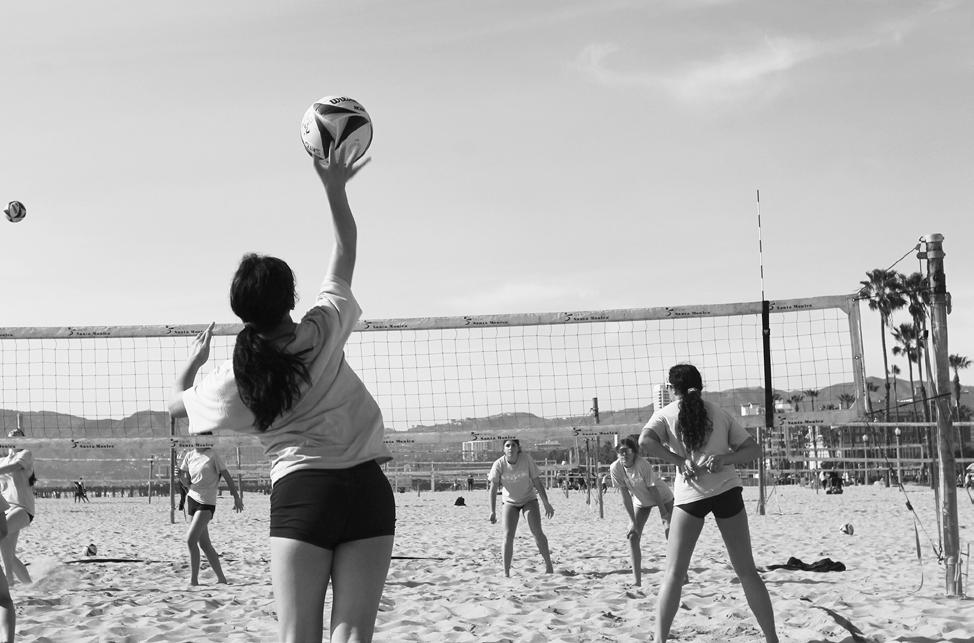
not very deep. Another difference is you have to have all of the skills, you have to be able to pass that hit, since there’s only two people on the court.”
In the Bay League, the girls play against teams like Mira Costa, Redondo and Palos Verdes- some of the top beach volleyball teams in the state of California. Last year, the teams had a new format- a combination of regular league season and league playoffs, where the teams competed for qualifications for CIF playoffs. Last season, Samo lost in the third round of league playoffs, eliminating them from CIF contention.
The team has grown to 33 players in the last three years, many of which are student athletes either in normal girls’ volleyball or in other sports. Sato highlights some players to look out for in this season.
“We’ve gotten a lot better,” Sato said. “This year we have a lot of new girls, incoming freshmen, who are new to the game, but they’ve been picking it up really quickly in the last couple weeks. We have some really great players. We have Jasmine Martinez, who is a returning player, [and] Ariana Ballard. We also have another developing player Layla Gafari and some other girls who are returning, who have gotten better.”
In addition to being its own sport this season, Sato believes that beach volleyball can also aid her athletes in improving their abilities in indoor volleyball.
“[Beach volleyball] is the neutralizer,” Sato said. “You don’t need to be super big and tall, although it helps. You have to have skills, you have good ball control, you can hit it, whether or not you can dictate where you want the ball to go. It really helps your indoor game, where you can
learn all of the skills and work on the skills that you need improvement on.”
Jasmine Martinez (’26), a player in beach volleyball, discusses the team’s main focus for the current season.
“The goal is to improve our skills,” Martinez said. “Each individual skill, because in beach volleyball, you have to know how to do every skill. It’s really just skill improvement. [We’ve improved] by pushing each other to do our best in every practice and really focusing on what we’re doing and trying to have that kind of mindset to improve.”

thesamohinews@gmail.com
Ryan
Staff Writer
Samo varsity baseball has gotten off to a solid start this season, posting a 5-4 record in spring training with the regular season set to begin on Tuesday, March 11.
Samo’s 2024 campaign ended in heartbreak following a 4-1 loss to Chino Hills in the Division 5 CIF championship game. The Vikings took the momentum from a third place Bay League finish into playoff season, leading to victories over Nogales, Ganesha, Adelanto and Pacifica en route to the final. Unfortunate-

ly, a trip to Chino on May 17 saw them fall just short of their CIF dream.
Samo lost a plethora of key seniors last season, highlighted by Jackson Klein—who mustered two no-hitters along with a 0.62 earned run average (ERA) and 101 strikeouts (K’s)—and Theo Smith, who led the team with his 0.382 batting average (BA). A loss of nine graduating players has opened the roster up for last season’s top performing juniors to spearhead a CIF redemption run. Head coach Jordan Sigman shared his expectations for those filling the shoes of last year’s seniors.
”We expect to compete in every game that we play in and have a very strong group that is very capable of winning the league and the CIF,” Sigman said. “We have some really strong firefly leaders, specifically Isaac Liberman (’25) and Manny Lares (’25). They are fierce competitors and hold the other guys accountable to ensure good effort and focus.”
The Vikings suffered a late shock away at South Torrance in their spring training opener, as the Spartans hit an unfortunate walk-off two run home run off Eddie Jennings (‘25) to steal the game 6-5. In their two games since, Samo took control early with a couple of monster first innings and elite performances on the mound, leading to consecutive 4-0 and 7-6 victories over Highland and Winward. Gavin Kirtley (‘25) had a dominant outing in Samo’s home opener, registering a staggering 13 K’s in six shutout innings while allowing just three baserunners. Returning senior Isaac Liberman has set the tone at the plate with five doubles in eight games, and Brady Satinover (‘25) has nine stolen bases to his name, picking up where he left off last season. The Vikings have since enjoyed victories over Tor-
back
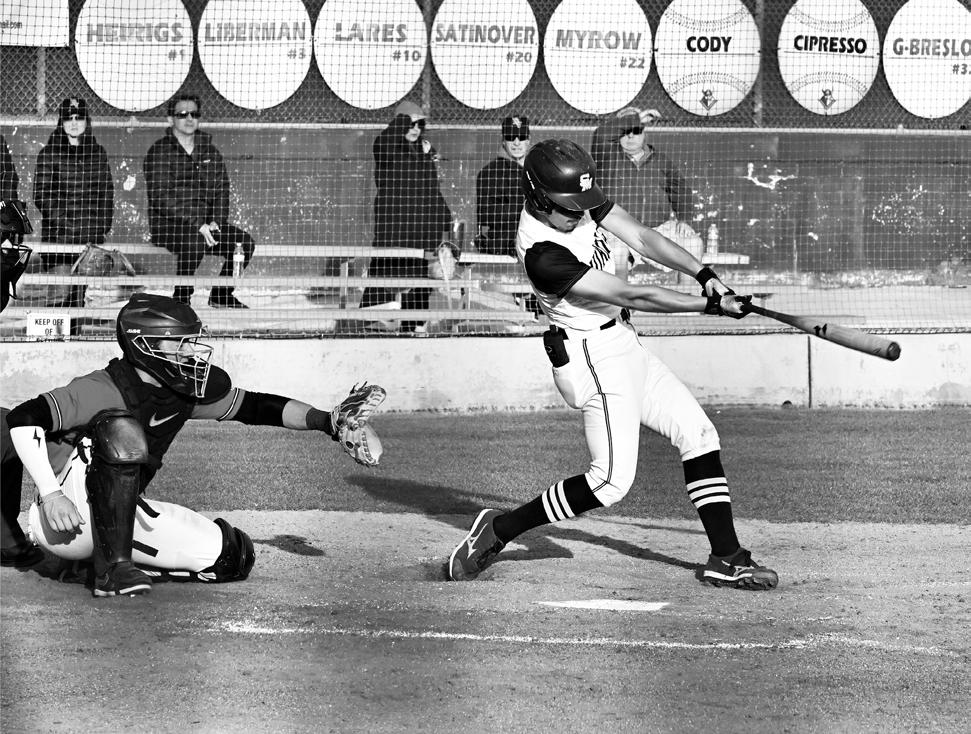
games against Capistrano Valley. They will host their home league opener on Thursday, March 13 against Centennial. Blue Hunter (’25) shared his expectations for the rest of the season. “As a captain I just make sure we’re getting all of our work in and everyone is doing their jobs; we have lots of team bonding activities we do that keep us together,” Hunter said. “Our goal for this season is to win CIF because we lost last season which was terrible, and we’re extremely motivated to win this year.”
thesamohinews@gmail.com
Ryan Kim Student Life Editor
During their previous ‘23-’24 season, the Samo track team broke school and personal records, reaching the CIF finals as individuals and relay teams.
Last year, the boys’ track 4x100 placed third at the Bay League Finals, heading to the CIFSS preliminary with a time of 42.84, which included current captain Logan Hanvey (‘26), Charles Rusler (‘24), Spencer Hotch (‘24) and Giovanni Crabtree-Ireland (‘25). In addition, the girls’ 4x800 also competed in the CIF playoffs. Reign Snowden (’24), who won the title of Bay League champion and com-
peted in both shot put and discus, and moved from CIF-SS preliminary rounds to the CIF Masters meet after placing in 4th with all divisions combined. Along with Snowden, Phoebe Benun (’24), the current team captain, moved into the CIF Masters, placing just outside of the top 10 in the 1,600-meter, while her team of Cleo Topp (’25), the 800m Bay League Champion, Maeko Gross (’25) and Matilde Martinez (’24) finished sixth in the 4x800 relay.
The track team’s season began on Feb. 26 with its first meet against Venice High School. The boys’ track team broke some personal records: Joshua Lesley (’25) broke 52 in the 400, and three sophomore boys went under 2:10 in the 800.
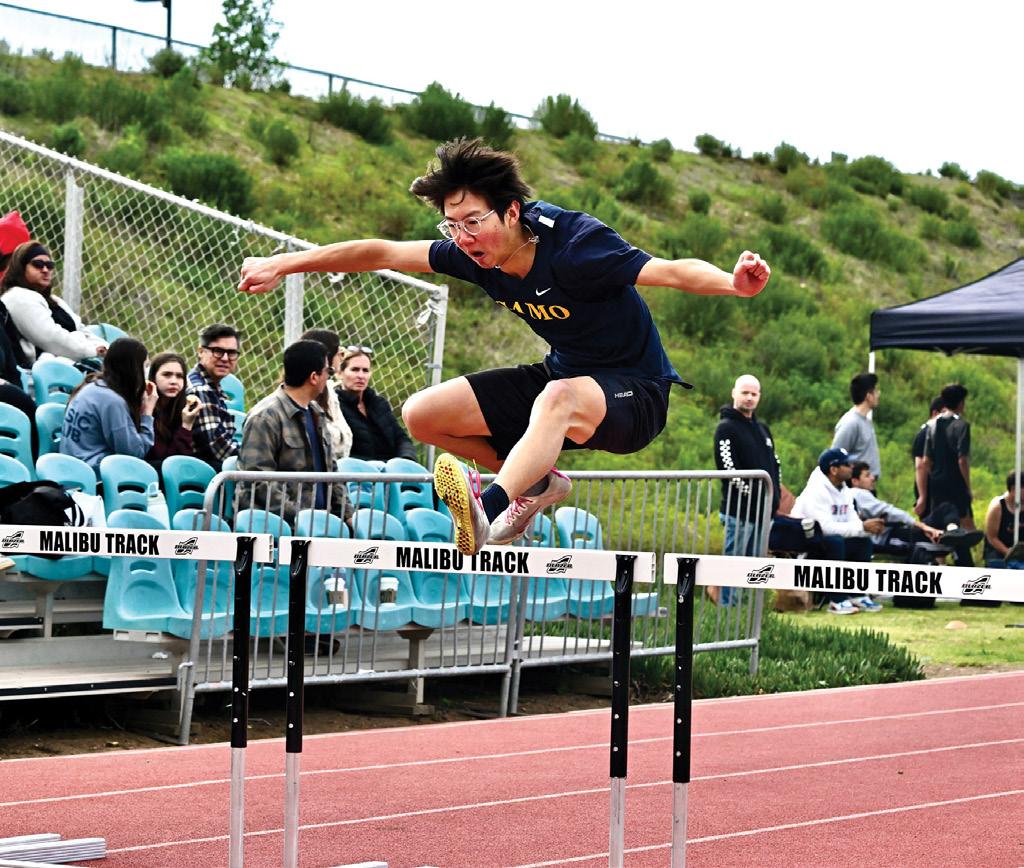
In the girls’ varsity track, Shenandoah Markos (’26) won the 200 and the 400 women’s, breaking her records of 26.70 and 1:01.13, respectively.
Lucas Yarmand (’25) said they’ve been preparing for this season by logging more miles per week and setting a high bar so everyone realizes how they are doing and where they need to improve.
“The team’s dynamic is just as strong as ever because of the larger team,” Yarmand said. “There are more people to talk to,
bringing in our community. The team is always cheering for other members, even when they’re not racing.”
The track coaches began their preparations for the season after hosting their three All Comers meets on Feb. 15, which are the tryouts for their upcoming season. Katie Saunders, one of the assistant track coaches, sports medicine teacher and kinesiology major, focused on caring for the body through stretching, rolling and listening to the body.
“I would love to have the lowest rate of athlete injuries this team has ever seen compared to past years,” Saunders said. “It’s difficult when you’ve got a team of 100 people… but the goal is to have them all healthy and strong.”
The track team has five main coaches, one for each type of event: distance, throw and strength, sprinters and hurdles and jumps. Emily Sutherland and Christian Castro focus on distance, while Saunders covers throws and strength. Al Backey III prioritizes sprinters, and the head coach, Richard Rucker, focuses on hurdles and jumps. After Tania Fischer, the previous coach, retired the previous season, Saunders believes that while she can never replace Fischer, she hopes to bring out the best in each athlete and make them confident in themselves.
“I’m building my own reputation, setting up my own goals and starting a new chapter. I’m learning and accepting her as a mentor,” Saunders said. “We’re [the coaches] gonna get them feeling confident, confident in each other, confident in themselves and working
together every day.”
Though the coaching staff is relatively new to the team, Benun said that the team has been adjusting since the beginning of the school year and are thankful for the support they get. Though communication was tricky at first, Benun said it’s improved significantly, as the coaches, such as Saunders, will tend to each athlete’s needs without hesitation and provide equipment for athletes to improve their recovery.
“We have much more variety in event specialists than in previous years because we now have a full-time throws coach in Coach Katie and a full-time jumps & hurdles coach in Coach Rucker. Madam Smith is our unsung hero who takes attendance for our team every day and occasionally helps time our workouts,” Benun said. “It is looking to be an exciting season full of personal bests and great competition!”
As the season continues, with freshmen adjusting to the track and the team preparing for upcoming meets, Yarmand and Benun are excited to break records and continue creating a supportive environment.
“We have many relay teams and individual events where we are looking to qualify for CIF this year. Our sprinters continue to find great competition within our league as they race some of the best sprinters in the nation from Culver City,” Benun said. “I would like to qualify for the state meet in either the 1600 or the 3200, but I have never qualified for State in track.”
thesamohinews@gmail.com
Olivia Stephansen Social Media Manager
Samo boys’ lacrosse ended their ‘23-’24 season as Ocean League Champions for the second consecutive season. Their overall record was 10-6 as they swept the league 5-0. Their record led them to compete in CIF playoffs where they lost in the second round of playoffs to Mira Costa High School. Head coach James Phelan shares his aspirations following last season’s end in the quarter-finals,
“Our goal is always to win the league. It’s always our number one goal, and then to make a deep run in the playoffs,” Phelan said. “We have some great players. We started seven freshmen last year who are now sophomores so that’s gonna help out with our outlook for the season. We returned a few guys from the championship team two years ago who are now seasons and leaders of the team. The ones who are going to be leading the team and setting that standard and that expectation of excellence for the program.”
This year’s current seniors this season are Jack Nash (’25), Nicholas Brownrigg (’25), Connor Lee (’25), Sevan Sawadogo (’25), Mateo Valecillos (’25) and Steven Petramale (’25). The captains are, HenryOwen Miyoshi-Grebler (’25), Dea-
con Recsnik (’25), Bryce Schatzow (’27), Trevor Havel (’27) and Ozgood Hawkins (’25).
Starting off the spring ’25 season strong with a 5-3 record they won their first home game against Palos Verdes High School with a final score of 13-9. Although the rain put a halt to the Vikings’ next home game, the season resumed with a 12-6 win at home vs Agora High School. Unfortunately, their winning streak ended at a tough home loss falling to a final score of 8-19. However, their losing streak ended quickly as the Vikings faced Palisades Charter High School and ended with a 23-14 win where Hawkins scored his 200th goal for Samo as a captain, he shares his thoughts for the upcoming season,
“My goal for the season is to win the Division Two championship. As a captain, I help the team by leading them by example and showing them the right way to do things. I hope to improve this season by working better with my team this year,” Hawkins said.
The team hopes to keep their winning streak with a win against Redondo Union High School on March 19 at Belmar.

thesamohinews@gmail.com
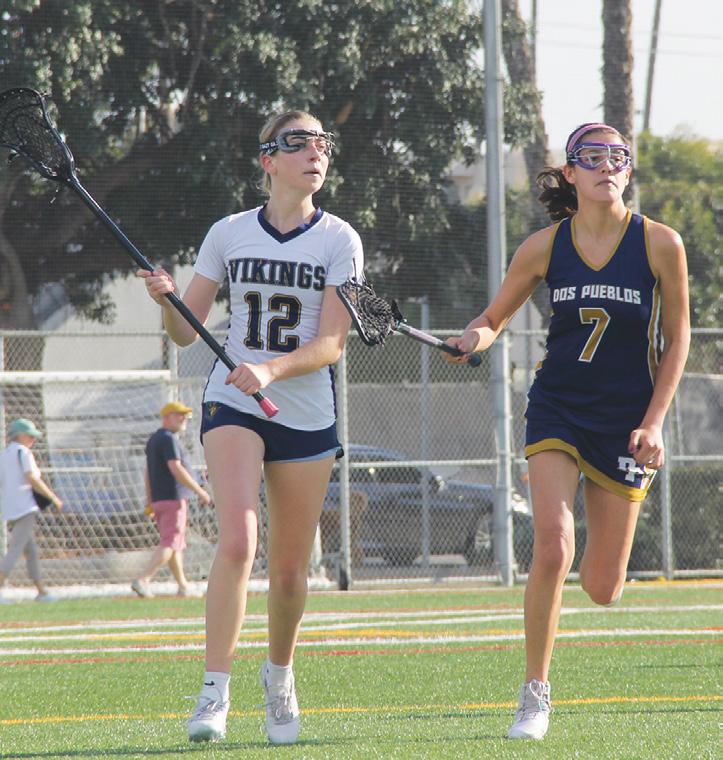
Samo girls’ lacrosse officially started their 2025 season on Feb. 2 against Hart High School. After a challenging 2024 season, the team finished with a 5-10-1 record in the Ocean League. The team faced key motivating wins, such as their impressive 20-5 victory against Beverly Hills High School, but ultimately tough competition and some close losses kept them from making the CIF playoffs.
The Vikings are off to a powerful start this season. They won their first game with a dominating 22-13 win at Hart High School. They played their first home game on Feb. 19 against Saugus High School, ending in an 8-19 score. The girls’ next home game was against Dos Pueblos, finishing in another close loss of 9-10 on Feb. 27.
On March 1, Samo played in the Rose Bowl Jamboree Tournament, losing
against University High School and El Dorado High School with scores of 1-8 and 3-14, respectively, and winning against Chadwick High School with a score of 105.
This commanding start sets the tone for the rest of the season ahead. Samo looks to win the Ocean League and make the CIF playoffs. Head Coach Brian Patenaude shares his expectations for the upcoming season.
“I want the team to give their all any time they’re on the field and supporting their teammates on and off the field,” said Patenaude. “One of our biggest strengths this year is our athletes’ personalities. Each individual personality brings a great dynamic to our team as a whole.”
This season the team gained 15 new freshman players, eager to make their mark on the field. Coming back more
determined than ever, ready to guide the team, are captains Tehmina Zarin (’26), Hayden Hansen (’25) and Ila Labb (’25). Hansen offers insight into her process of leading and motivating the team.
“I would definitely say our biggest strength is our team spirit. We’re very supportive of one another and as we work through difficult games and challenging practices we’re always there for one another. As a team we want to work on our offense and defense, and also make sure we are working together and working our hardest in all our games,” Hansen said. The Vikings’, currently at a record of 2-6, will play their next home game against Culver City High School on March 21.
thesamohinews@gmail.com